




b c FRANKEL - Reem Three
Queen Anne Stakes Gr.1
Bred by Sheikh Mohammed Obaid Al Maktoum
br h FRANKEL - Handassa
Prince of Wales’s Stakes Gr.1
Bred by Shadwell Estate Company Limited (IRE)
Courage Mon Ami
b g FRANKEL - Crimson Ribbon
Ascot Gold Cup Gr.1
Bred by Hascombe & Valiant Stud Ltd
b f KINGMAN - Helleborine
Sandringham Stakes
Bred by Juddmonte
b f EXPERT EYE - Illumined
Chesham Stakes L.
Bred by L H Laroche
b c KINGMAN - Turret Rocks
Jersey Stakes Gr.3
Bred by Farmleigh Bloodstock Ltd

More 2023 Royal Ascot winners than any other stallion farm…

1st Irish 2000 Guineas
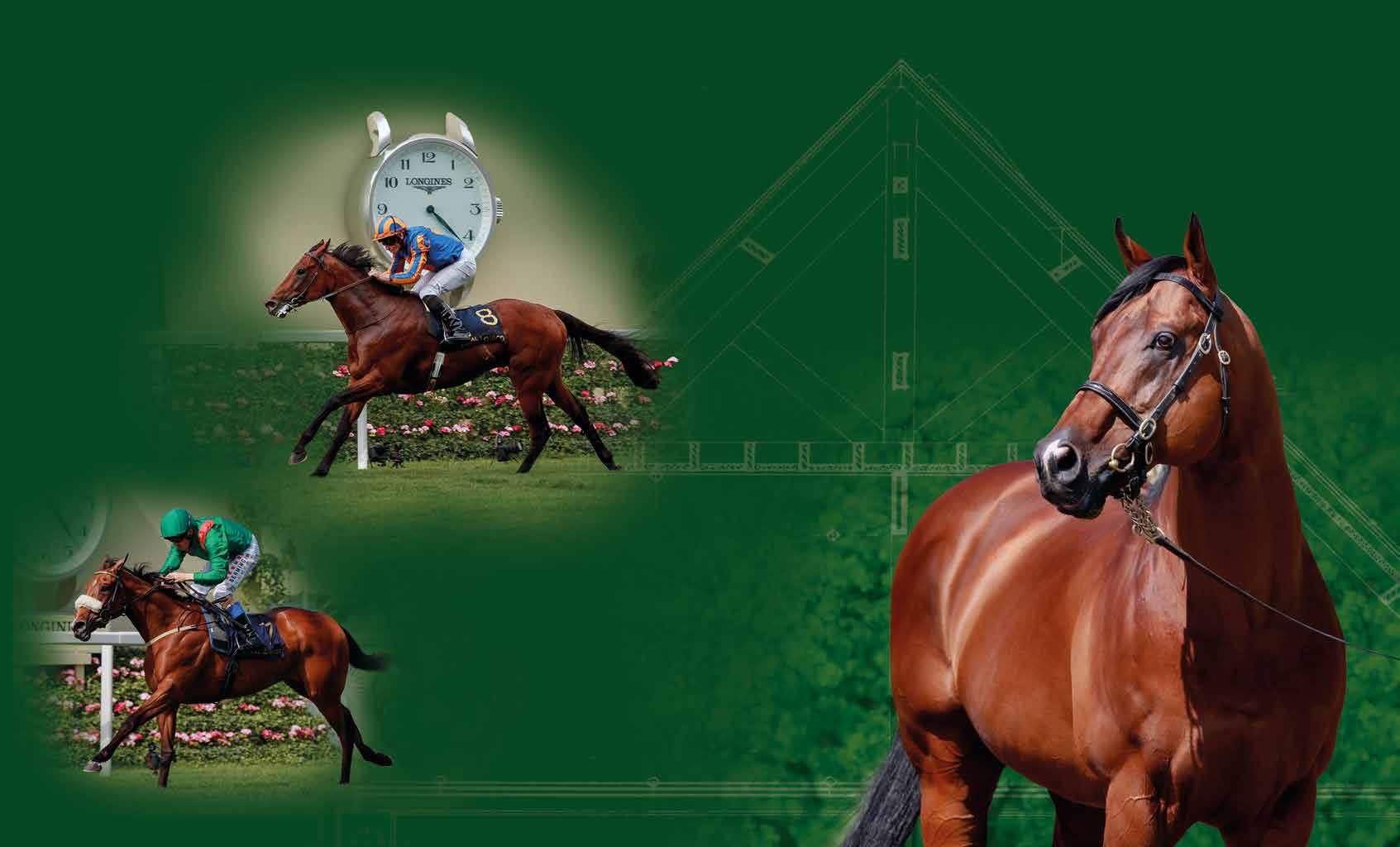
1st St.James’s Palace Stakes
The best milers of their generation
1st Irish 1000 Guineas
1st Coronation Stakes


The leading sire of three-year-olds in Europe in 2023
8 First Word
Life through a lens: the wonderful equine work of the late John Reardon, former Fleet Street and then Darley photographer, has been remembered in the exhibition “(after) Whistlejacket”
14 Ted talks
It is so important for the promotion of the British racing and breeding that there is international participation at Royal Ascot, writes Ted Voute
16 Girls Aloud
Cathy Grassick had a great time at Royal Ascot, a week which saw Royal winners and Irish winners, and a big result at the Goffs London
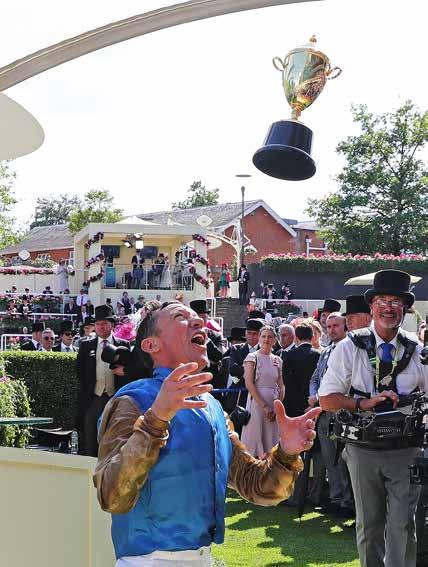
20 Triple header
Amy Bennett reports from an outstanding Royal Ascot for Frankel, the sire of three Group 1 winners, while a diverse range of sires enjoyed a good time of it, too
30 Classic impact
Jocelyn de Moubray looks back on the first European Classics and believes Auguste Rodin and Ace Impact are very, very good Derby winners
38 No standout this year
There were three separate winners of the US Triple Crown races and Melissa Bauer-Herzog reviews all of the important action stateside
42 In full bloom
It’s 50 years since Nelson Bunker Hunt’s Dahlia ruled Ascot, twice winning its mid-summer showpiece.
Sally Wright from Timeform profiles the middle-distance Queen of the 1970s
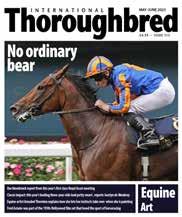
46 Horses for causes
The Good Racing Company sends all its profits to charity, James Thomas chats with CEO Phil Hawthorne
54
We talk to the award-winning and ITB December front cover artist Annabel Thornton about her passion for horses and how that has influenced her career and her work
60 Tinseltown and Turf
Recently published letters from Hollywood legend Fred Astaire to his racehorse trainer Jack Leach reveal the star’s love of racing and gambling
70 Photo finish
The first ladies of Royal Ascot: Hayley Turner and Hollie Doyle
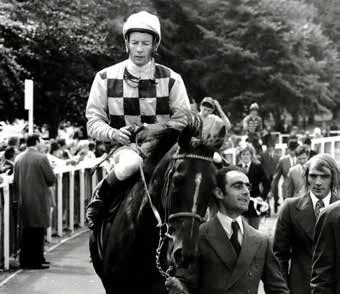
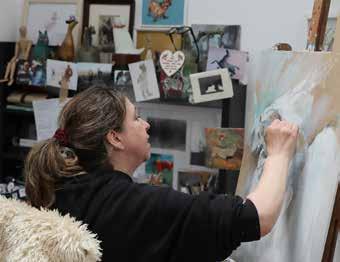
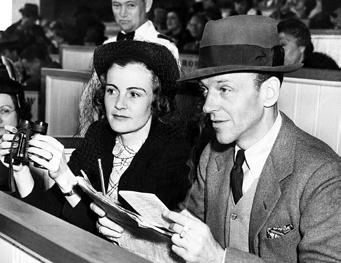
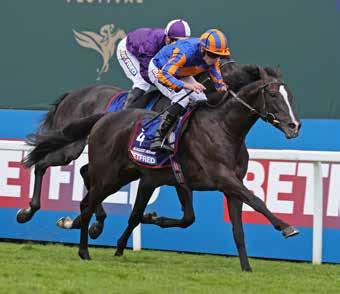
FITTINGLY, if bearing in mind the equine art theme in this May-June issue, this edition of First Word features a selection of amazing photographs by John Reardon chosen from the exhibition (after) Whistlejacket, contemporary equine photography.
Reardon, who died at 66 from lung cancer in 2018, became Darley Stud’s official photographer in 2001, after a successful career in photojournalism through which he produced images for the news pages and the Sunday supplements showing the stark reality of wars, conflicts and natural disasters in the 1980s and 90s.
(after) Whistlejacket was the brainchild of Reardon’s widow Sacha Lehrfreund, who has painstakingly archived and collated his work. The words are by Jocelyn Targett, friend and work associate of Reardon and creative consultant for Darley.
“It has been tiring and emotional, but also great fun archiving John’s 1000s of photographs,” says Lehrfreund, who managed to complete the task alongside her day job as picture editor for Darley. “I remember John being so mesmerised by the Whistlejacket painting, that striking image of the horse against the plain background, that we decided to use it as the title for the exhibition.”
The exhibition at MMX Gallery in London has been extended to July 15, but you can also view the images on instagram.com/johnreardonarchive. Lehrfreund also hopes to take the exhibition on tour, with Newmarket a first stop. We will keep you informed of plans.
IT WAS A GORGEOUS DAY down in the stallion yard. Birdsong, sunlight urging the most wizened of faces into a squinty grin, a few scudding clouds. A four-year-old colt – called, with good reason, Untouchable – snorted and jig-jogged as he was walked up and down. Half-a-ton of testosterone with teeth, and a magnificent swishing tail, and four pointed hooves.
Photographs were required for his new calling card – a side-on portrait to show off his immense musculature, that neck cresting like a perfect wave; and a few “incidentals” to reveal some character, his lustrous eye, perhaps, that deep jaw and broad chest, the poised power of a rare stationary moment. The photographer clicked, and ducked, and moved, and clicked again. He cooed at the horse, he cooed at the groom, at once instructing and becalming.
Click, duck, “Yes!”, move, “Back a little – yes!”, click.
Then he stood up, handed over his camera, wriggled out of his capacious leather jacket – an ageing thing, black of course, but too lengthy to be fashionable, and with the soft shoulders of something made well over a decade before –and, sweeping away at his own foppish forelock, he lay on the grass right in front of the horse, rolled on his back and shimmied ever closer to those steel-strong hooves, each as big as a bucket. Untouchable stood stock still. Were he to paw at the earth in front of him, as he was so often prone to do, we’d have been needing a new photographer. Click, shimmy, shimmy, click. The never-before seen view of the underside of a racehorse’s head.
That was John Reardon all over, seeing familiar things entirely afresh, finding danger in the most bucolic and benign of scenes and, wizened and grinning, going over and beyond (or indeed under and below) to take a better photo. Or, rather, “make” a better photo. The distinction,
“That was John Reardon all over, seeing familiar things entirely afresh, finding danger in the most bucolic and benign of scenes
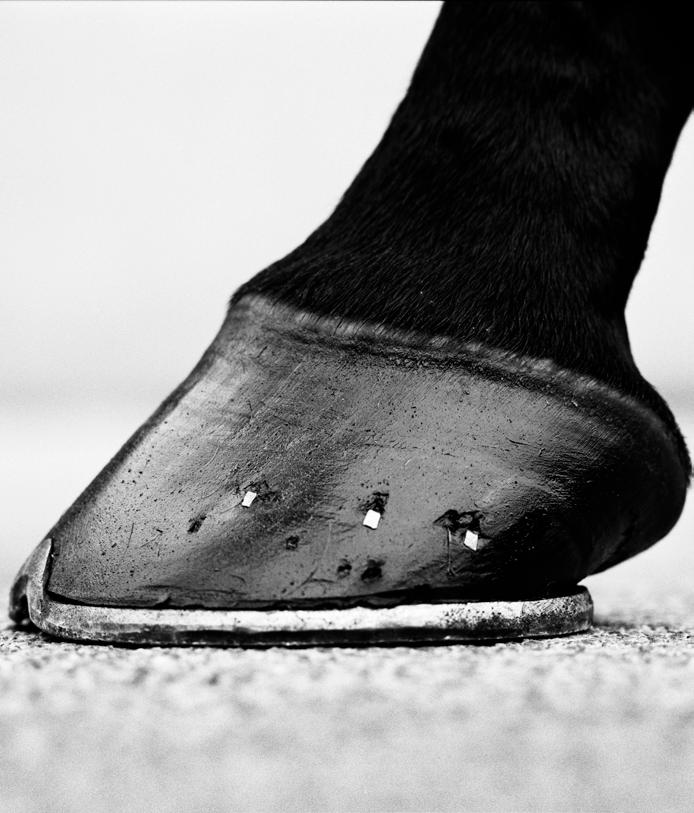
which he insisted upon, was not so much pretentious as ambitious: his images were always intended, never stolen.
These photographs of thoroughbred stallions raced by Sheikh Mohammed of Dubai’s Godolphin stable, began as a half-derided summer job – “Just commercial work!” he would wince, appalled by the revolting vulgarity of privilege and prosperity.
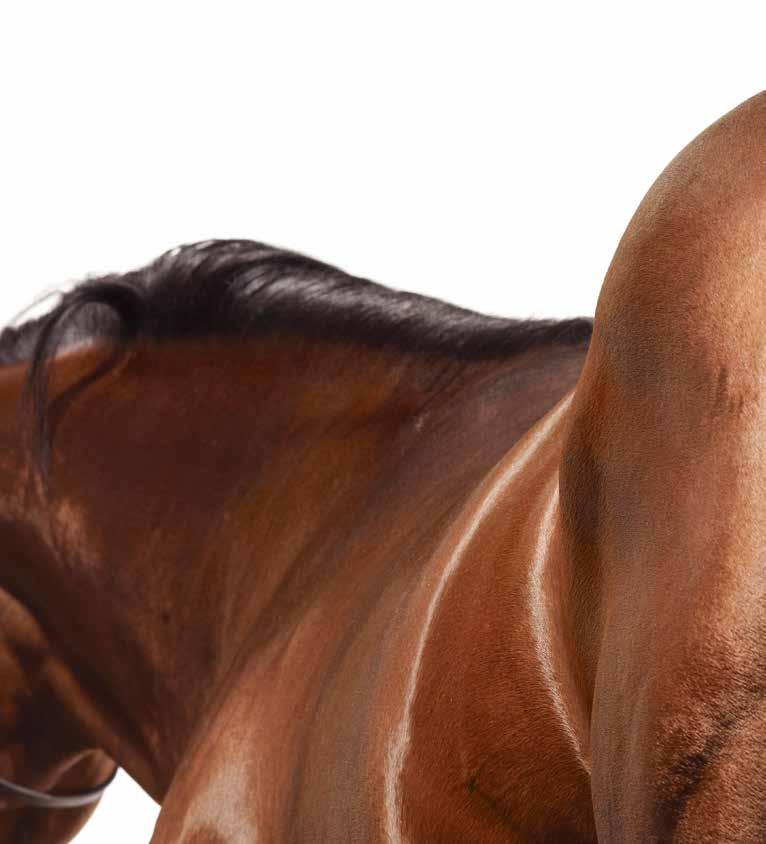
It lasted 16 years, almost until his death at 66 five years ago.
Back when it all began – on the eve of his 50th birthday and after photographing 14 wars and untold natural disasters for news pages and Sunday supplements, the kind of stark, stylish foreign forays that newspaper budgets
would less and less stretch to – he might have feared that he was retiring to grass. In fact, it was to be one last wild ride.
For weeks at a stretch, it took him to Ireland and France, Kentucky and Japan, Australia and, of course, Newmarket. That newly shod hoof? It belongs to Cape Cross, who went on to father one of the all-time greats of the game, Sea The Stars. That arcing neck? King’s Best, sire, too, of a Derby winner.
The dappled grey in front of a dappled wall is Sagamix, hero of Europe’s greatest race, the Prix de l’Arc de Triomphe. Mark Of Esteem, winner of the 2,000 Guineas under jockey Frankie Dettori back in 1996 (Dettori won the race for a fourth and final time
“...began as a half-derided summer job –“Just commercial work!” he would wince, appalled by the revolting vulgarity of privilege
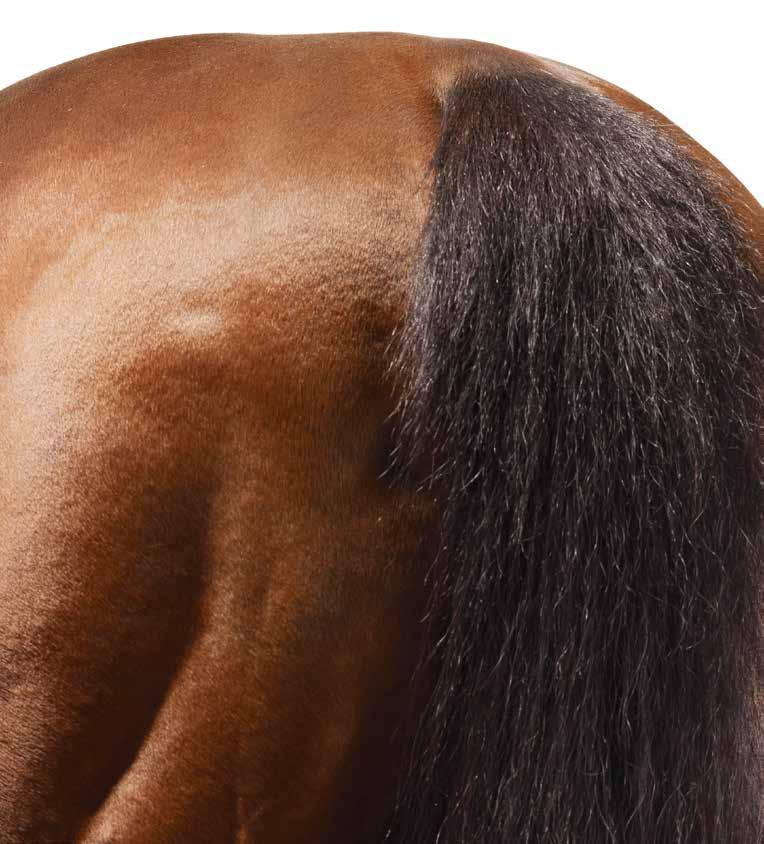
in May this year), paces in the shadows of a beech avenue, prettily silhouetted.
Reardon’s work coincided with a new ambitiousness at Sheikh Mohammed’s stud group, named Darley after one of the three Arab stallions from which all racehorses descend.
Soon, his black and white images had been wallpapered over the entire racing world – adverts in the racing press and in race day racecards, hardback brochures with all the self-belief of gallery catalogues for the grandest retrospectives, billboards in racing towns and even adorning the vast sides of the occasional grandstand.
“Now see them in colour” was the strap line, as the Sheikh’s people threw open the wrought ironmongery that guarded his imperious stud farms and invited in racing professionals and horsey enthusiasts alike.
It worked a treat. As the century ticked by, 26 stallions boomed to more than 60. Every year, Reardon re-invented his challenge. He photographed them with a special 65mm panoramic Hasselblad, turning the line of neck, withers, back and quarters into lush landscapes.
He created a portable studio of all-white walls and had the stallions stare into his lens as if they were movie stars.
One year, he went to photograph every major race, wherever it was run, anywhere in the world: he’d unfailingly find the story and tell it in a few startling frames – ever eclectic, ever hectic. He was out at dawn. He was there at dusk. He climbed trees to get a better view and once inadvertently buzzed the Sheikh in his private swimming pool while hanging out of a helicopter.
Thousands of rolls of film. And when you look at one or two of them – spread out on a lightbox, through a Lupe, yellow Chinagraph poised: the way he insisted we all did for as long as he could hold the digital world at bay – you see what an extraordinary gift he had. 36 exposures, at least 20-25 different scenes or set-ups. Yes, he’d work a shot; but mostly he got what he wanted first time and that was that, he’d moved on, gone, tirelessly creative, his imagination fizzing like a lit fuse.
Racehorses, and the people in their realm, turned out to be his ideal subjects. Reardon’s eye found the elegance, power, and plaintive vulnerability of whatever settled before his camera, and the thoroughbred is abound with elegance, power and vulnerability. He stared down from his rakish 6ft3in with the most humane, even sentimental, of gazes. You see it across his work, across the years: people – and horses – rarely look better than in their John Reardon portrait. Click, duck, move, click. It might have started out as a job, but eventually it became his oeuvre.
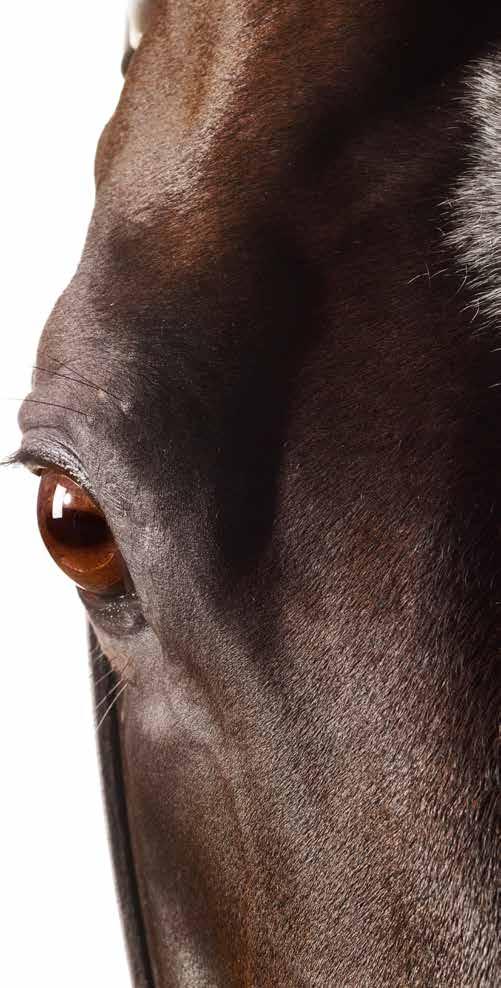

ICONTINUE TO MARVEL at the ability of Royal Ascot to attract varied and consistently high-quality runners from around the world.

It is very important that British racing attracts foreign runners –the knock-on effect promotes our racing and breeding; ultimately overseas owners, it has to be hoped, will invest in our country at many levels.
Ascot has been at the forefront promoting its racing on the world stage and enticed runners this year from Hong Kong, Australia, the US as well as the regular European runners.
This is, slowly, resulting in some US breeders producing horses in Ireland or England and, subliminally, investing in our bloodstock industry; either through ownership or breeding; people want to participate.
Attracting owners to British racing through international runners is one route we haven’t
used nearly enough.
The spin off is that there is good and healthy competition to own the best horse in the world on the World Rankings.
Goodwood and York are making inroads and are getting foreign-trained runners to their Festival meetings, too.
Many of the enticement ideas seem to originate from the Breeders’ Cup team through its “win and you’re in” entry scheme
The tremendous hospitality when you attend race meetings abroad is evident – from Hong Kong’s International race meeting and now including Dubai, Qatar, Bahrain and Saudi Arabia.
Over time this will, hopefully, turn full-circle and winners trained in these countries will have assisted travel or guaranteed places in some of our top races.
Not only have we seen a shift in overseas runners, but increasing the foreign ownership base is growing – the latest important addition to the UK ownership ranks
It is so important that the internationals come to race their horses at Royal Ascot for the continued promotion of British racing, argues Ted Voute
is the Emir of Qatar, who enjoyed instant success at the Royal meeting this year.
American owners have been prominent also this week with runners trained domestically.
Despite our domestic struggles with prize-money, Royal Ascot continues to stand alone as the place everyone wants their horses to compete.
Ascot has become our biggest promoter – and when Their Majesties the King and Queen have a winner in the first year of the new reign it can’t help but promote our industry.
The Royal Family’s attendance every day attracted attention, investment and is, on a wider scale, great for tourism.
It is hard for breeders or bloodstock agents to promote their farm or success without an idea to sell, but Ascot, and especially Royal Ascot, creates stories for the front pages.
British racing and breeding needs all the help it can get, and everyone wants a horse that they have bought or bred to run at Royal Ascot.

The partnership with World Pool, that allows betting pools to co-mingle, and has captured the attention of global bettors.
As these punters begin to follow the form of the top horses it means that not only will they bet more, but will also develop a greater understanding of international racing.
Historically, Hong Kong’s worst betting days in terms of financial turnover have been the international race days as their domestic population didn’t follow the form of the internationals who
then travelled to Hong Kong to take on the domestic runners.
If we could use a similar model to increase overseas investment, whether it be through running overseas horses or breeding and training in the UK, we will find a way to increase the prize-money or increase multiple ownership.
British-based trainers left Ascot this year with 24 winners almost twice that of any other country, but the British-breds are still unable to beat the Irish.

However, drilling down into what constitutes a “Britishbred” isn’t as simple as where a broodmare band is based, and it should be!
It is misleading that the horses produced by British owners, who foal their stock in other counties, are not classified as GB-bred.
Can I ask that this small issue be changed? It would give a much clearer picture of the breeders based in the UK and support stallions here, particularly the world’s leading sires Dubawi, Frankel and Kingman.
Despite our domestic struggles with prize-money, Royal Ascot continues to stand alone as the place everyone wants their horses to compete

Cathy Grassick, chairman of the Irish Breeders’ Association, enjoyed Royal Ascot and got to see both Royal and Irish successes
ROYAL ASCOT is the race meeting like no other and this year it really showed why horseracing is known as the “Sport of Kings”.
The daily attendance of Their Highnesses King Charles and Queen Camilla was wonderful to see but it was tinged with sadness at the memory of Queen Elizabeth II no longer with us; the wonderful bookies’ bet on the colour of her attire and her huge enthusiasm for this fantastic week of pageantry and racing.
If anyone was in any doubt of King Charles inheriting the Queen’s love for horseracing, they were to stand corrected very quickly.
Both King Charles and Queen Camilla were out of their seats cheering home Desert Hero in the King George V Stakes on Thursday.
Trained by William Haggas and ridden by Tom Marquand this son of Sea the Stars was bred by The Queen and the Royal family were clearly very emotional in the aftermath of the race. How special it must have been for the whole Royal family to see her breeding continue to shine on the international stage.
With over 250,000 people attending over the five days and the meeting televised in over 200 different territories it is clearly a formula that works and holds huge attraction for racegoers and viewers alike.
It always makes me marvel at the huge passion for Royal Ascot, given that it has a dress code and rules and regulations that, while
relaxed from days gone by, are stricter than any other meeting. Elsewhere other racecourses spend their time and money trying to make the sport more accessible to the average person on the street.
The beauty of Royal Ascot is that every day is in fact a “ladies day”, everybody goes to such huge effort to look their best, even the men have to put in the effort!
There is no need to pay for big name entertainment as stars from all walks of life are more than happy to be there – famous names such as Demi Moore, Richard E Grant, Dame Judi Dench, Alan Carr and Amanda Holden among those in attendance.
Even the equine stars all come out to shine during the five-day meeting and this year was no exception with Paddington, King Of Steel, Tahiyra, Khaadem and River Tiber some of the big names to light up the winners’ enclosure.
There were some very special moments as always at Royal Ascot and I am sure that Willie and Jackie Mullins were already having a day to remember when part of the Royal procession, but the commanding performance of Vauban on the same must have been the icing on the cake.
The Irish trainer has created a fantastic dual-purpose career for this talented son of Galiway. In fact, Willie Mullins was not the only NHt trainer to have a winner at Royal Ascot on Tuesday with Nicky Henderson also victorious with Ahorsewithnoname.
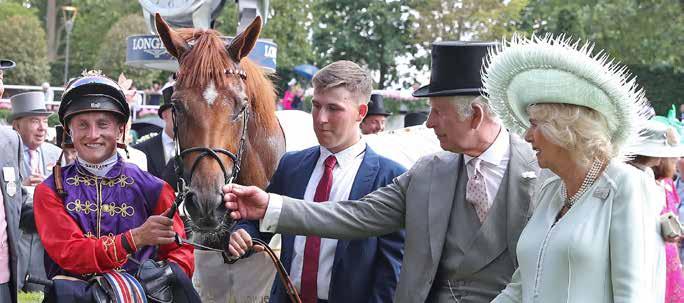 An emotional Royal Ascot winner: King Charles and Queen Camilla congratulate Desert Hero on a job well done in the King George V Stakes
An emotional Royal Ascot winner: King Charles and Queen Camilla congratulate Desert Hero on a job well done in the King George V Stakes
Another very emotional victory came on the last day when Pyledriver put in an astonishing performance after an absence of almost a year to win the Group 2 Hardwicke Stakes for William Muir and Chris Grassick.
It was very clear to anybody watching the joint-trainers being interviewed just how much love, care and attention had been given to this horse in order to get him back to his full potential.
It was also clear how important this was to both the staff in the yard and his owners. I may be more than a little biased (as a proud cousin of Chris) but I have to say I found the victory thrilling and I can imagine many others did, too. Roll on the King George VI and Queen Elizabeth Stakes!

OF COURSE, we cannot write about Royal Ascot without mentioning the great Frankie Dettori, who has won 81 races at the Royal meeting, and who was riding in the last Royal Ascot of his career. Not only did he win his ninth Ascot Gold Cup (G1) with Courage Mon Ami, but was also victorious aboard Porta Fortuna, Coppice and Gregory.
It was poignant to hear the great showman of racing speak after his final ride at Royal Ascot and his unique brand of showmanship will be missed from the parade ring in the future.
Not all of the great stories took place on track and one of the great stories of the week was at the Goffs London Sale on the Monday before the meeting.
Attendees at the sale in Kensington Palace gardens on the eve of Royal Ascot were treated to a wonderful spectacle of enthusiasm as consignor Con Marnane climbed on the bid spotters’ rostrum and happily took bids as his own Givemethebeatboys sold for an incredible £1,100,000 to Bronsan Racing; the Marnanes having purchased the horse for just €11,000 the previous autumn.
It was a wonderful result for Con, his wife Teresa and daughters Amy and Olivia, as well for trainer Jessica Harrington, who has handled the colt so well, and for whom he finished a close fourth in

the Group 2 Coventry Stakes on Tuesday. He is an exciting prospect to follow for the rest of the year.
The celebrations didn’t end quietly, and in true Marnane fashion, were still going strong at the Irish picnic in Car Park 2 on Wednesday!
It was a wonderful week to be part of, but after a number of days of dressing up and hats and finery, it was more than a relief to get back to the farm and normal life.
The break was short lived – the Tattersalls Ireland Derby Sale followed hot on the Flat meeting’s heels, and then the Irish Derby Festival, which started on Friday with the ITBA Flat seminar before evening racing.
This was an exciting evening with a debate on distance – sprinters, stayers and everything in between, Sally Ann Grassick was the host and guest panellists Kevin Blake, Ado McGuiness, John Oxx, Stuart Boman and Jason Morris. Entry was free to breeders, owners and trainers and included admission to races and refreshments.

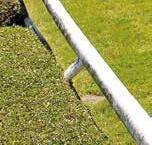
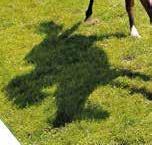
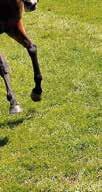
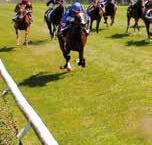
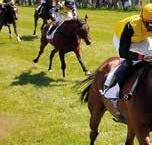







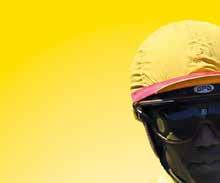
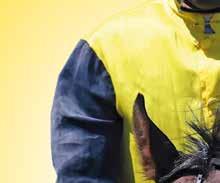


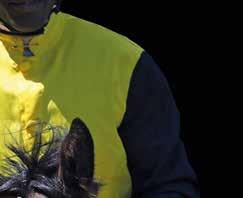
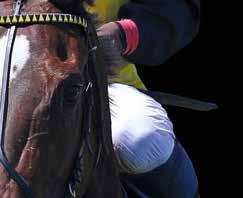
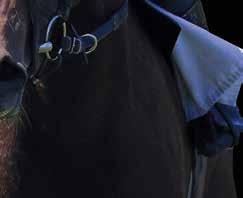


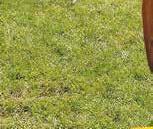





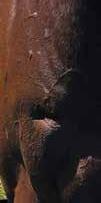
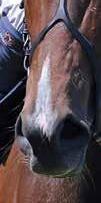


IT WAS A BONANZA WEEK for Juddmonte sires, past and present, headed of course by the kingpin himself, Frankel.
Twice triumphant himself at the Royal meeting, and successful five times in all at the Berkshire track, Frankel
the course of the week, three Group 1-placed performers and a conditions runner-up.
The leading sire got the ball rolling in the first race of the meeting with Triple Time triumphing in the Queen Anne Stakes (G1), 11 years after Frankel routed the opposition in the same race by 11l.
prevalent as breeders seek to outcross the saturation of sire sons of Galileo.
From a a mile winner at the highest level on Tuesday to the winner of the extreme 2m4f of the Gold Cup (G1) on Thursday –Frankel managed it all.
Courage Mon Ami, racing for the Amir of Qatar’s Wathnan Racing, took his unbeaten record to four with a mammoth leap from a Goodwood handicap in late May to success on the biggest stage a month later.
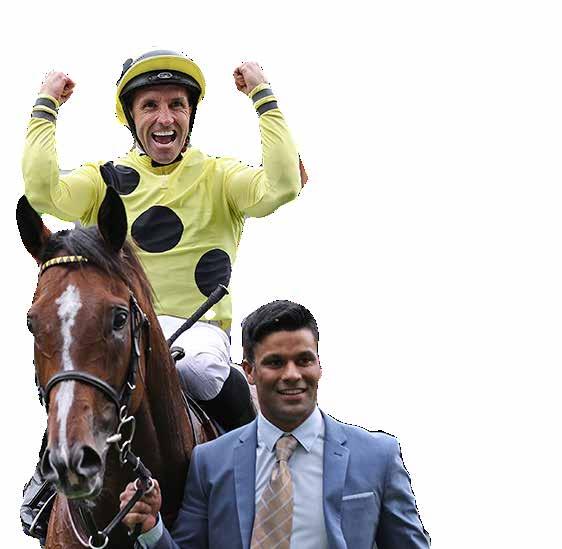
A graduate of Anthony Oppenheimer’s Hascombe & Valiant Studs, the four-year-old gelding is out of the maiden winner Crimson Ribbon (Lemon Drop Kid), a full-sister to the Hascombe luminaries Bronze Cannon and Valiant Girl. The mare has already enjoyed success with Courage Mon Ami’s threeparts siblings Crimson Rosette (Teofilo) and Astronomos (New Approach), both Group 3-placed Listed winners, as well as the Listed-placed Purple Ribbon (Gleneagles).
As well as being represented by his Classic-winning son Chaldean, runner-up in the St James’s Palace Stakes (G1), and the Queen Alexandra runner-up The Grand Visir, Frankel was also represented by a further two place getters – as a broodmare sire, just for good measure.
His stud mate Kingman, who, like Frankel, triumphed in the St James’s Palace Stakes (G1), also secured a sizeable piece of the action, siring two winners and two placed horses.
First, came the Juddmonte homebred Coppice, who stayed on well in the Sandringham Stakes to take her record to three wins from four runs. A full-sister to
Frankel topped the Royal Ascot sires’ list with an outstanding three Group 1 winners, but there was diversity in the stallion-winning ranks, too, writes Amy Bennett
the high-class sprinter and first-season sire Calyx, out of the high-class Helleborine (Observatory), from an outstanding and storied Juddmonte family, the filly holds an eye-catching entry in the Falmouth Stakes
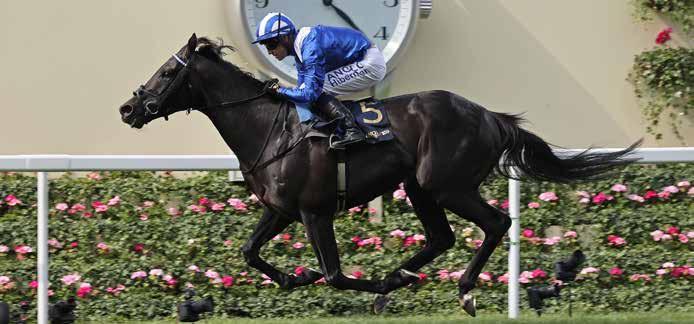
(G1) and looks to have plenty more to come. Age Of Kings (Kingman), a 1,100,000gns yearling purchase, may have more racecourse experience than Coppice, but his success in the Jersey Stakes (G3) on the final
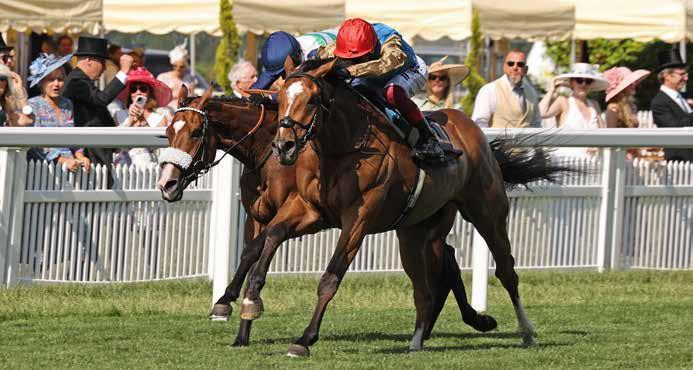
day of the meeting was also his first success at black-type level. It was also a second successive Jersey Stakes winner for his sire, who was responsible for last year’s winner in Noble Truth.
Out of the May Hill Stakes (G2) heroine Turret Rocks (Fastnet Rock), who went on to score at Group 3 level at four and five, the colt was well-beaten in the Irish 2,000 Guineas (G1), but was prominent throughout in the Jersey, scoring by a comfortable length.
It did look briefly as if Kingman’s Fred Darling Stakes (G3) winner Remarquee – out of a daughter of former Juddmonte sire Champs Elysees – may get up in the Coronation Stakes (G1), however, Tahiyra (Siyouni) was always doing enough to hold her in second, with another of Kingman’s daughters, Sounds Of Heaven, a head away in third.
The final day of action saw a breakthrough first stakes success for Juddmonte’s young sire Expert Eye as Snellan landed the Listed Chesham Stakes. The son of Acclamation scored himself at Royal Ascot in 2018 when taking the Jersey Stakes, so it was a fitting first black-type winner for him.
A maiden winner at Limerick just ten days earlier, the filly was bred by owner Lindsay LaRoche out of the Listed-placed Sea The Moon mare Illumined, who raced for George Strawbridge. A half-sister to the Group 3 winner Night Lagoon, dam of the top-class duo Novellist and Magical Lagoon, among others, she was purchased at the 2020 Tattersalls December Mares Sales for 170,000gns by Harvey Bloodstock, carrying this filly.
Rounding out the action for the Juddmonte sires, former inmate Cacique sired the Ascot Stakes winner Ahorsewithnoname on the opening day, while Oasis Dream enjoyed success as a broodmare sire with Big Evs (Blue Point) in the Listed Windsor Castle Stakes, and St Lawrence (Al Kazeem) in the Wokingham handicap.
A trio of Kentucky-breds brought a touch of the stars and stripes to the Royal turf, starting with the filly Crimson Advocate
(Nyquist) in the opening race of the second day.
In the last 15 years, the Queen Mary Stakes (G2) has been won by four fillies trained by Wesley Ward, most recently with Campanelle in 2020. On this occasion, Ward’s runner Bundchen (Gun Runner) beat only four, but the George Weaver-trained Crimson Advocate got up to pip Relief Rally (Kodiac) by the narrowest of margins.

Previously a winner on Turf at Gulfstream Park in mid-May, the filly was bred by Whitehall Lane Farm out of the Proud Citizen mare Citizen Advocate. She is a graduate of the OBS October Yearling Sale in Florida, where she was purchased for $100,000, a destination far from the usual fayre for Royal Ascot winners.
The Kentucky Derby (G1) victor Nyquist has now produced 15 Group or Graded juvenile winners, although this was his first-ever runner in Britain.
A US-bred was also to the fore in the Norfolk Stakes (G2) on Thursday, albeit this time trained in Ireland. Valiant Force became the joint-biggest priced Royal Ascot winners of all time when scoring by a length and a quarter at 150-1 for trainer Adrian Murphy and owner Amo Racing.

The son of Malibu Moon was clearly highly regarded at home as he made his debut in Listed company, finishing runnerup to His Majesty (No Nay Never) in the First Flier Stakes on May 1.
Later that month, he was beaten just over 5l when fifth of six behind Givemethebeatboys (Bungle Inthejungle) in the Marble Hill Stakes (G3).
However, horses are unaware of their odds, and the colt produced a classy performance to give owner Kia Joorabchian his first success at the Royal meeting.
Twice a graduate of Keeneland, the colt is the first foal out of the Quality Road mare Vigui’s Heart, from a family full of blacktype, albeit none at the highest level in its immediate generations.
A trio of Kentucky-breds brought a touch of the stars and stripes to the Royal turf
Rounding off a hat-trick for US-breds was the Derby (G1) runner-up King Of Steel, who franked the Epsom form with an impressive success in the King Edward VII Stakes (G2). The colt was foaled in Kentucky, but boasts a pedigree as European as they come – he is by Wootton Bassett out of the Verglas mare Eldacar, a winner at up to 3000m in France.
Bred by BCF Services LLC, the colt is another graduate of Keeneland, and hails from the family of Contributer, who went on to Group 1 success in Australia, having won the Listed Wolferton Handicap at the Royal meeting.

He was bought by Alex Elliott at Keeneland, Joorabchian reporting that Elliott told him then not to walk away from the sale without the colt on the purcashed list.
Crowned with Steel King Of Steel was one of a pair of Group 2 winners at the meeting for Wootton Bassett, who kicked off the meeting in style when his son River Tiber justified favouritism in the Coventry Stakes (G2).
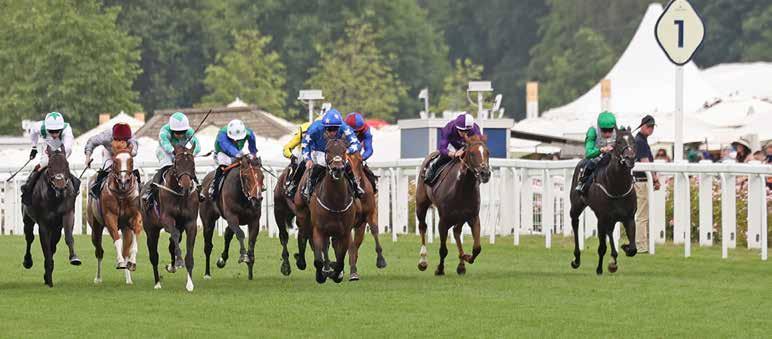
Although bred in Ireland by Pier House
Stud, who sold him for 480,000gns at Book 1 of the Tattersalls October Yearling Sale, the colt actually hails from the last Frenchconceived crop of his sire, who moved from Haras d’Etreham to Coolmore in summer 2020, just months before River Tiber was born.
River Tiber is out of the unraced
Transcendence, a half-sister to the Listed winner Mister Manannan and the Group 3-placed dam of the Phoenix Stakes (G1) winner Sudirman, from the family of such as Dandy Man and Anthem Alexander. The colt is now unbeaten in three starts, and he holds the usual glittering array of entries expected of a high-class juvenile inmate at Ballydoyle.
Other Coolmore sires to make it to the scorecard during the meeting included Australia, sire of Waipiro, who won well in the Hampton Court Stakes (G3), Caravaggio, now based in Japan and sire of the Group 3-winner Porta Fortuna, who gave Frankie Dettori his 80th Royal Ascot winner when triumphing in the Albany Stakes (G3), the late Mastercraftsman, who was represented by the Kensington Palace Fillies’ Handicap winner Villanova Queen and the Gold Cup runner-up Coltrane, and, of course, the late lamented Galileo, who was responsible for a hat-trick of scorers in the Ribblesdale Stakes (G2) heroine Warm Heart, Queen Alexandra Stakes winner Dawn Rising and Okita Soushi, who landed the Duke of Edinburgh Stakes.
Warm Heart and Okita Soushi were both bred under the Coolmore banner and both represent the cross of Galileo over a Fastnet Rock mare, while Turret Rocks, dam of the Jersey Stakes winner Age Of Kings, is bred on the reverse cross, giving Fastnet Rock a trio of winners as a broodmare sire.
Classic form to the fore for Siyouni

Also on “red-hot” sire form was the mighty Siyouni, who celebrated three winners, headed by the Group 1 winners Paddington and Tahiyra.
The Irish 2,000 Guineas winner Paddington could scarcely have been more
impressive in brushing aside the Newmarket 2,000 Guineas victor Chaldean (Frankel), while the Irish 1,000 Guineas heroine Tahiyra may have had to survive a stewards’ enquiry to win her third Group 1, but the daughter of Siyouni looks to have many more top-level successes ahead of her.
Siyouni rounded off his week with another success via the Buckingham Palace Stakes winner Witch Hunter.
Dubawi and sons
Dubawi made his influence felt during the Royal meeting with a winner of his own and another two sired by his sons.
Rogue Millennium achieved a memorable success for her trainer Tom Clover when staying on strongly to land the Duke of Cambridge Stakes (G2) by a neck from Random Harvest (War Front) to give the Newmarket-based handler a first Group winner and a first success at Royal Ascot.
A Listed winner last season, the filly has promised much but just been found wanting in three previous black-type starts in 2023.
However, she found her stride to become the first black-type winner out of the Cumberland Lodge Stakes (G3) winner Hawaafez, having been purchased for just 35,000gns as an unraced two-year-old at the 2021 Tattersalls December Mares Sale.
Dubawi’s sons contributed to the score sheet with Al Kazeem siring the Wokingham
winner Saint Lawrence, and New Bay providing the Royal Hunt Cup victor Jimi Hendrix.
Night Of Thunder also gets an honourable mention, thanks to the exploits of his top daughter Highfield Princess, who was runner-up in the King’s Stand and third in the Queen Elizabeth II Jubilee Stakes (G1) just three days later.
Dalham Hall Stud’s linchpin was also in action as a broodmare sire with his daughters producing the Prince of Wales’s Stakes (G1) winner Mostahdaf, as well as Desert Hero, who carved out his own piece of history when becoming the first Royal Ascot winner for King Charles III, when triumphing in the King George V Stakes.
Away from fashion’s spotlight
Fashion may rule at Royal Ascot, on and off the Turf, but there were a number of winners during the week who returned their little-lauded sires to the spotlight – always a pleasing result at a big meeting.
Just as the crowds cheered for smaller trainers, such as Group 1 Commonwealth Cup-winning trainer Julie Camacho, so breeders should applaud winners by sires who hail from outside the leading lists, celebrating diversity in a sport so often dominated by a handful of names. And what better place to start than with Camacho’s hero Shaquille?

The three-year-old is now winner of six of his seven starts and was bred by Martin Hughes and Michael Kerr-Dineen out of the Galileo mare Magic. He is the biggest winner to date by Charm Spirit, the son of Invincible Spirit who spent the early part of his career switching between Tweenhills Farm & Stud and Haras de Bonneval, before settling at Haras du Logis Saint-German, where his fee this year was €5,000.
The meeting also saw the winning return of the top talent Pyledriver, who landed the Hardwicke Stakes (G2) to set himself up for a return tilt at the King George VI & Queen Elizabeth Stakes (G1), which he landed last year. He is a son of another former Tweenhills inmate in the late Harbour Watch.
Also at the lower end of the fee scale is Mickley Stud’s Massaat, who stood for £4,000 this year and was represented by the Britannia Stakes winner Docklands, and Pearl Secret, who commanded an advertised fee of just £2,000 at Norton Grove Stud this year, and sired the Palace of Holyroodhouse Stakes winner Rhythm N Hooves.
Bradsell had already given his young
Shadwell sire Tasleet a first Royal Ascot success last year when triumphing in the Coventry Stakes (G2), but he went one step further this year when holding off the determined Highfield Princess in the King’s Stand Stakes (G1) on the opening day.
Hailing from the first crop of his sire, who stands at Shadwell’s Nunnery Stud, Bradsell was bred by Deborah O’Brien out of the Listed-winning Archipenko mare Russian Punch, whose only other winner to date is the handicap scorer May Punch (Mayson).
Bradsell himself was purchased for just 12,000gns out of the Tattersalls Somerville Yearling Sale, before reselling for £47,000 at the Goffs UK Breeze-Up Sale offered by Mark Grant Racing
Also celebrating a first Royal Ascot success was Golden Horn, who earned a high-profile move to Overbury Stud this year, and was represented by the Queen’s Vase winner Gregory, who stayed on well to triumph. The three-year-old – another winner for Wathnan Racing – is out of the Park Hill Stakes (G2) winner Gretchen (Galileo), a half-sister to the top stayers Duncan (Dalakhani) and Samuel (Sakhee).

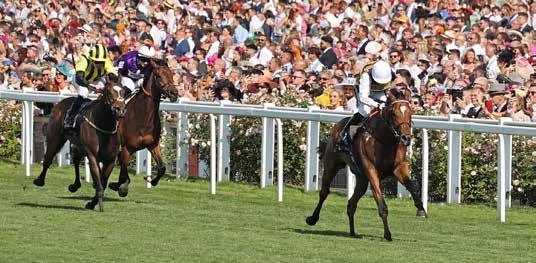
DARLEY’S FIRST-SEASON SIRE Blue Point cemented his position at the head of the table of leading first season sires when siring his first stakes winner at the Royal meeting.
Bigs Evs had previously finished runner-up at Redcar in late May on his racecourse debut, but produced a powerpacked performance to triumph in the Listed Windsor Castle Stakes, winning by 3l from Johannes Brahms.
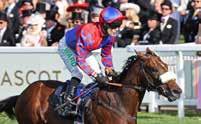
Bred by Rabbah Bloodstock out of the Oasis Dream mare Hana Lina, a placed daughter of the top filly Queen’s Logic, the colt was a fitting first stakes winner for his sire, who won three times at the Royal meeting and commanded a fee of €35,000 this year at Kildangan Stud.
By the end of Royal Ascot 2023, Blue Point had sired 14 individual winners, and topped the table of first-crop sires by prize money. His nearest numerical rival was Ballyhane Stud’s high-class juvenile Soldier’s Call, the sire of 13 winners up until 23 June.
Up to the end of Royal Ascot week, no other first crop sire had broken double figures with winners, with Tally-Ho Stud’s Inns Of Court next on seven.
Two sons of No Nay Never came next, with Highclere Stud’s Land Force and Coolmore’s Ten Sovereigns – responsible for the Windsor Castle third Inquisitively – both level on six winners.
Coolmore’s Calyx had sired five, while stud mate Magna Grecia had four on the board. The Irish National Stud’s Phoenix Of Spain had also sired five individual winners.
...breeders should applaud winners by sires who hail from outside the leading lists, celebrating diversity in a sport so often dominated by a handful of namesDocklands: scored for Mickley Stud’s Massaat, the meeting saw a range of stallions enjoy success Big Evs
European Flat sires (by prize-money earned to June 26, 2023) Courtesy of Weatherbys
biggest names in the business
Sensational Horse of the Year as a two-year-old, the best in the stallion-making family of Invincible Spirit and Kodiac, and the outstanding youngster by the sire of Lope de Vega and Blue Point. First yearlings at the sales soon...

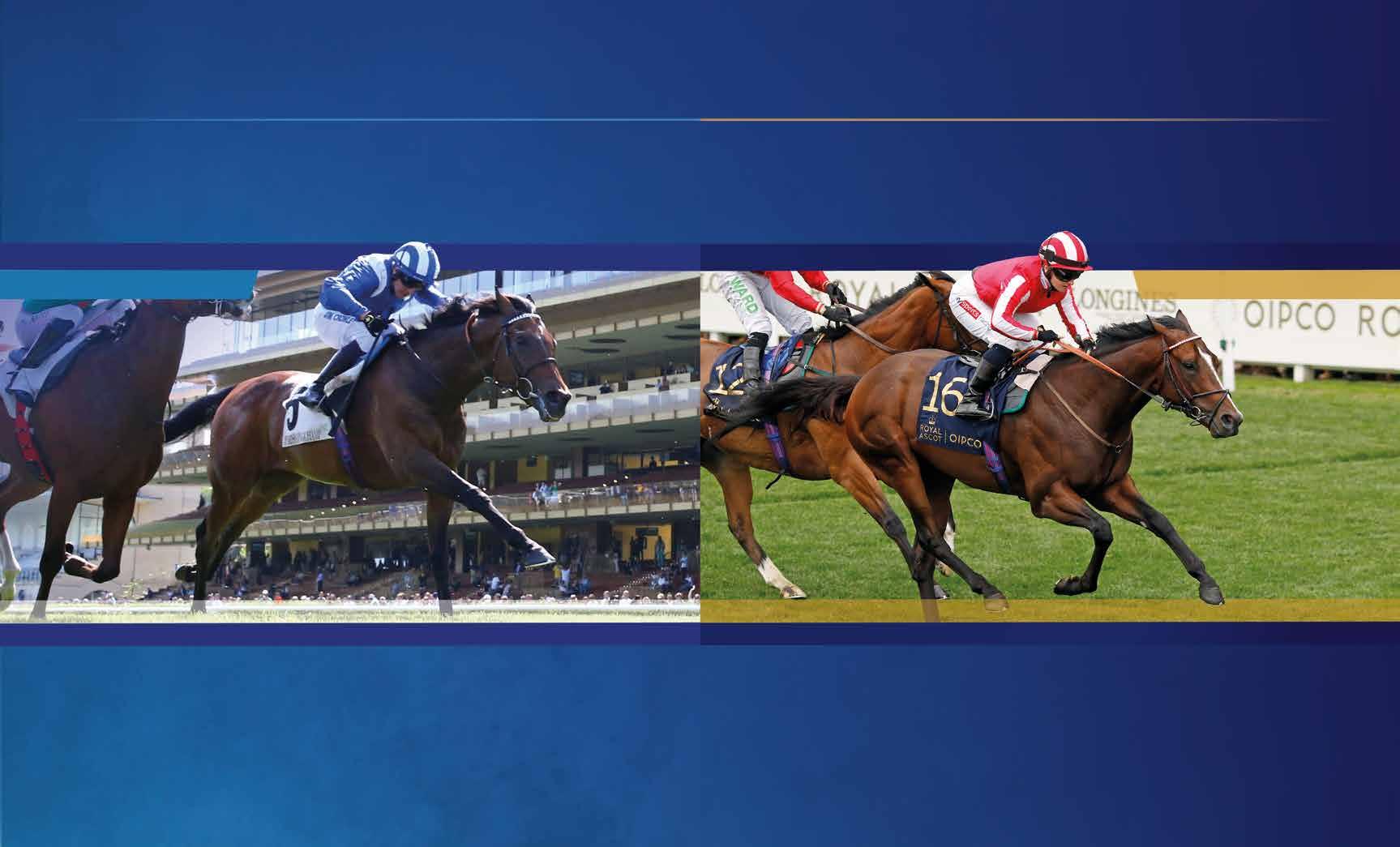



This year’s crop of leading three-year-olds looks a smart set, writes Jocelyn de MoubrayPhotography by Debbie Burt
Classic races at Epsom and Chantilly became recognised as such because they constituted a unique and searching test for three-yearold thoroughbreds, while at the same time providing an enthralling spectacle.
Of course, the years of running add to the interest by providing perspective to judge different generations, to be a focus for those who enjoy watching and betting on racing, and an efficient way of selecting elite stallions of the future.
The Derby at Epsom and the JockeyClub at Chantilly have both been through periods when one or the other of those purposes, and sometimes both, have looked in danger of disappearing and the races seemed sure to dwindle into irrelevance.

At the end of the 20th century there was a run of ordinary Epsom winners none of whom made any mark as a stallion, and moving the race from its traditional Wednesday transformed the nature of the spectacle and the composition of the crowd on the Epsom downs.
The 1m4f Jockey-Club produced the odd exceptional winner but only rarely was it a competitive race and it was becoming an event of limited international or domestic significance.
With hindsight it is clear that Galileo’s win at Epsom in 2001, the first for trainer Aidan O’Brien, gave Epsom’s race a chance to regain its status, while the decision to change the distance of the Jockey-Club to 2100 metres in 2005 has transformed the race’s standing and significance. The status of both races has yet to be fully secured, but Auguste Rodin and Ace Impact’s victories were not only fabulous spectacles but the manner in which they both came through their Classic test suggest they will be well supported the day they retire to stud.
For the second consecutive year the
Derby and the Jockey-Club fulfilled their purpose which has to be something to celebrate.
After Auguste Rodin had managed to finish only 12th of the 14 runners in the 2.000 Guineas, 22l behind the winner Chaldean, it seemed unlikely the son of Deep Impact would even run in the Derby and yet at the same time there was no other obvious contender to take over his place as favourite.
A cold and wet spring in Northern Europe meant that the Classic trials were more difficult to read than usual, and when it finally stopped raining and the Dante Stakes at York was run on good to firm ground the race produced a bunch finish with five colts, headed by The Foxes, finishing within 2l of each other.
On the day itself there was plenty of confidence behind the O’Brien-trained Auguste Rodin and he started second favourite only just behind Juddmonte’s Frankel colt Arrest, ridden by Frankie Dettori, who had won the Chester Vase on heavy ground, and Military Order, Godolphin’s full-brother to the Derby winner Adayar, who had won the Lingfield Derby Trial transferred to the All-Weather track after heavy rain.
The middle-distance Classic races at Epsom and Chantilly would be a severe test for three-year-olds even if they were run on a flat, straightforward racecourse.
At this time of year three-year-olds are developing fast; if you take the official weight-for-age table the average threeyear-old improves 9lb between May and July when racing over 1m2f, and the best of them can make spectacular progress in the space of a few weeks.
Enable, for instance, went from a Racing Post Rating of 111 at Chester on May 10 to 123 at Epsom three weeks later.
The nature of the track at Epsom tends to exaggerate the difference between good horses and very good ones, and thee
preparation required and the test itself often means that the middle-distance Classic races are the peak of a horse’s career rather than a stepping stone on to other better performances.
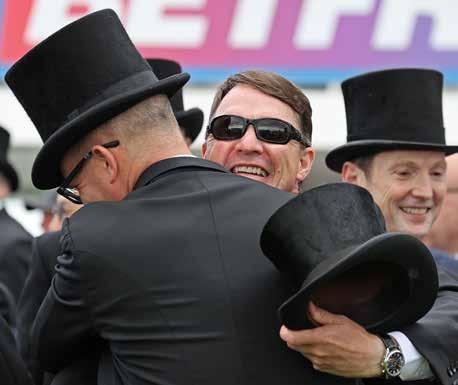
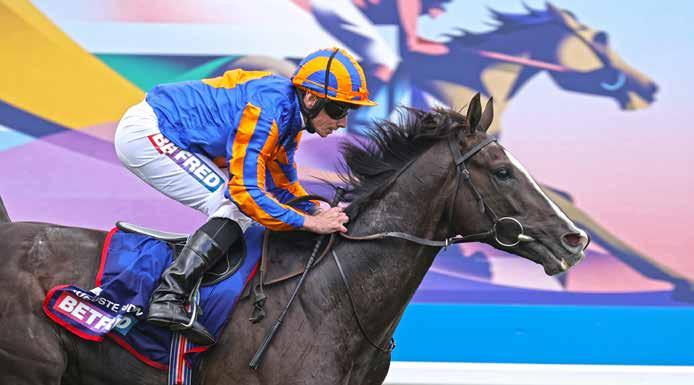
At this stage there is no way of knowing whether or not Auguste Rodin or the Derby runner-up King of Steel will continue to improve and perform at the highest level, what is clear, however, is that they both put up by far the best performances of their career to date, and one which compares with the best Derby performances of recent years.
During the race this pair were the only two who ever looked to have a winning chance.
Auguste Rodin’s stable companions Adelaide River and San Antonio made the early running, while Ryan Moore kept Auguste Rodin towards the rear away from the rails to be sure of having a clear run in the straight. With 2f to run, when the course begins its climb towards the winning post after the long run down Tattenham Hill, jockey Kevin Stott sent King Of Steel to make his challenge. To the surprise of
most of those watching you would imagine – the son of Wootton Bassett, a 66-1 shot, is a giant standing 1m73 and far from the type normally considered suitable for the undulations of Epsom and who was making only his third career start.
He raced away from his rivals into a clear lead.
Moore, watching from behind and perhaps concerned for a moment, sent Auguste Rodin in pursuit. The son of Deep Impact accelerated, but the leader was not stopping and it was only close to the post that the O’Brien colt was on top, winning in the end by a half length with four and threequarters of a lengths back to the remainder headed by the Irish trial winners White Birch and Sprewell with the non-staying The Foxes back in fifth.
Simon Rowlands of Attheraces has calculated that the only horses to have run the Derby straight in a faster time than Auguste Rodin and King Of Steel are Nijinsky and Galileo, two great Derby winners in more than 50 renewals on every type of ground.
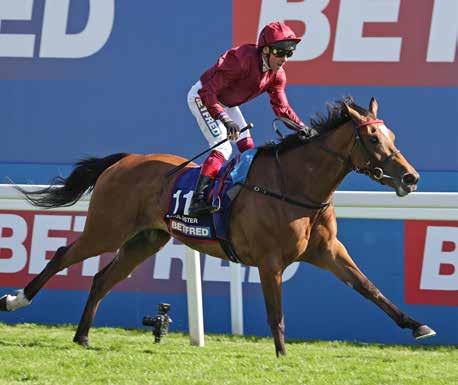
AUGUSTE RODIN gave his trainer a record ninth winner of the race but more than this achievement the colt’s looks and pedigree made this a special moment for all those involved and many of those watching.
By Deep Impact, a stallion whose progeny have dominated the strongest middledistance racing programme, out of a Galileo mare Rhododendron who was an exceptional racemare, Auguste Rodin has a lot going for him as a future stallion.
His fourth dam Rahaam, bred by Calumet Farm, was by the Epsom Derby winner Secreto and out of a mare from the family of the Florida Derby winner Royal And Regal. Her best product was the top sprinter Cassandra Go, who was purchased as a yearling by Trevor Stewart. Cassandra Go’s best product, the Group 1-winning Pivotal mare Halfway To Heaven, was bought by the Coolmore partners as a yearling and she in turn produced Rhododendron who raced 19 times at two, three and four, winning a Group 2 at two, finishing second to Enable in
the Oaks and, after pulling up in the Diane, coming back to win the Opera at the end of the year and the Lockinge as a four-year-old.
Auguste Rodin is her first foal and as his trainer recounted after the race he has always been considered by Coolmore’s experts to be an outstanding physical individual – not only does he have the head and look of his grandsire Sunday Silence, but as O’Brien put it his measurements and
balance have always been among the very best.
Another very special aspect of Auguste Rodin’s record is that before being an outstanding Derby winner he was a top class two-year-old, he made his debut in June and went on to win a Group 1 over a mile.
Of the principals in this year’s middledistance Classic races he is the only one who ran in a Group race as a two-year-old before the end of the season.

The Oaks winner Soul Sister ran once at two winning a maiden in October, her runner-up Savethelastdance was unplaced on her only juvenile start, while of the first four in the Jockey-Club the only two-yearold winner was Marhaba Ya Sanafi, who won an All-Weather maiden at the end of November. King Of Steel and White Birch each made two starts at two winning a maiden in October and finishing unplaced on their other starts.
Two-year-old racing now has very little relevance to the middle-distance Classic races run in June.
The rest of the word has slowly but surely
...the only horses to have run the Derby straight in a faster time than Auguste Rodin and King Of Steel are Nijinsky and GalileoSoul Sister: was one of two Classic winners this year for sire Frankel, also grandsire of Ace Impact
become aware of the excellence of Japanese breeding.
Deep Impact, who produced Auguste Rodin in his last and 13th crop, has sired six English or French Classic winners, and among those stallions who never stood in Europe only Northern Dancer and Kingmambo (on seven apiece) have a better record.
During the decades at the end of the 20th century any breeder who hoped to compete with the best in Europe had to go to America to buy from the best breeding programme in the world to upgrade their stock. Today just as naturally the leading breeders will go and buy in Japan.
Japanese breeding has already moved on from Deep Impact and, while he remains the country’s leading broodmare sire, he does not appear in the pedigree of the nation’s current top five young stallions –Duramente, Lord Kanaola, Maurice, Kitasan Black and Satono Crown.
Of these five only Kitasan Black, who is by Deep Impact’s brother Black Tide, is from the Sunday Silence line and while Kingmambo’s stallion sons disappointed in Europe three of Japan’s best are grandsons of Kingmambo – Lord Kanaola, Duramente
and Rulership are all sons of King Kamehameha.
What has not changed is the type of stallion who succeeds in Japan. All of these horses are Group 1 winners in a system were the number of Group 1s is and always has been limited. There are 25 Group 1s in Japan and 16,000 races so 0.15 per cent, while in Europe there are 84 Group 1s and 14,000 races so more than four times more at 0.62 per cent of all races.
All three also raced through several seasons and, with the exception of Duramente who made only nine starts, they all raced at least 12 times.
In contrast to England and Ireland the French Classic generation of 2023 has looked to be particularly strong and right from the beginning of the year.
At the time of writing there have been 40 Group and Listed races in France for threeyear-olds over more than 6f and, despite many runners from England, Ireland and Germany, there have been only two winners who were not trained in France, Aidan O’Brien’s Greenland and Archie Watson’s Brave Emperor.
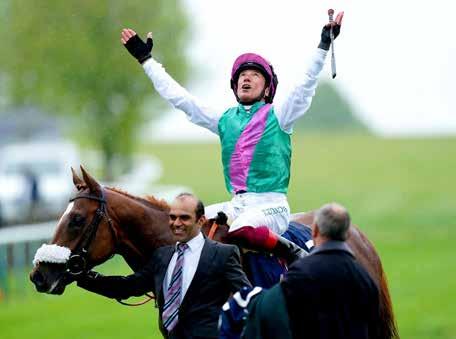
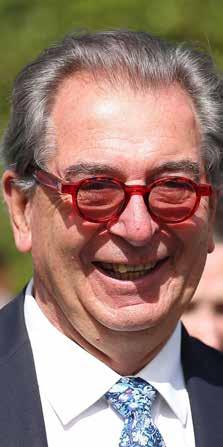
This may simply be a coincidence or a chance event, but there is also something else going on as the way in which the better races in France are run has been transformed.
Christopher Head, the trainer of at least two of the best members of the French Classic generation in Poule d’Essai des Pouliches winner Blue Rose Cen and JockeyClub runner up Big Rock, has played a significant part in this transformation.
With his stable jockey Aurelian Lemaitre, Head’s runners more often than not set out to make the running, which by French standards, is often at a strong pace.
At the same time, and there is no way of knowing whether this has been a reaction or another coincidence, both André Fabre and Jean-Claude Rouget seem to have changed long-standing habits and their horses, too, are often seen in the lead setting a good pace.
Fabre and his stable have been helped by the arrival of new stable jockey Bauyrahan Murzabayev and in his 78th year Fabre has a new spring in his step. Murzabayev may have not convinced every French observer and trainer as yet but his patron seems to be
enjoying this new partnership.
The principle French-trained contenders went into the Jockey-Club with a near perfect record.
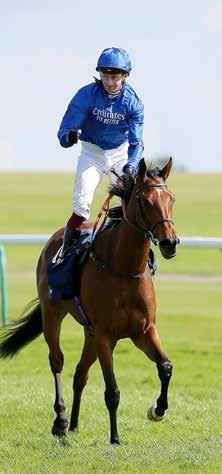
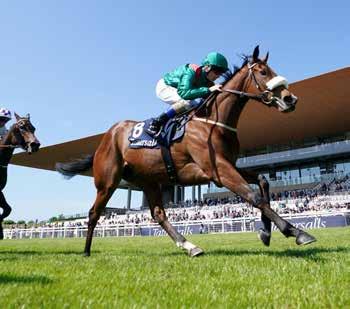
Ace Impact had made his debut at Cagnes in January and had won all three of his starts very comfortably for Rouget and owner Serge Stempniak.
The Head-trained Big Rock had won all four starts for the stable from the front without being extended, while the Pascal Bary-trained Feed The Flame had won both his starts with ridiculous ease. The Poule d’Essai des Poulains winner Marhaba Ya Sanafi had only ever been beaten by the top soft ground performer American Flag on heavy ground, since making his debut for trainer Andreas Schutz.
Only two foreign-trained horses travelled to Chantilly – the John and Thady Gosden trained Epictetus, who had finished second to Auguste Rodin in the Group 1 at two, and the O’Brien-trained Continuous.
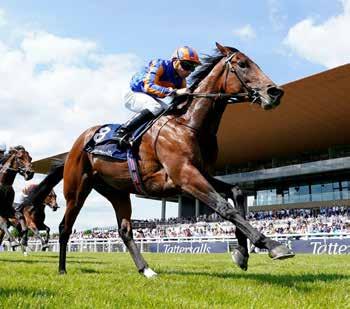
As everyone was expecting Big Rock and Lemaitre set off in front at a very fast pace, not quite as fast as the pace Lemaitre had set on Motamarris in Sottsass’ Jockey-Club in 2019 but faster than any other Jockey-Club since Shamardal made all the running to win the first over 2100 in 2005.
Christian Demuro riding Ace Impact was
no doubt expecting the race to turn out in this manner and he settled Ace Impact in last place. Big Rock’s relentless galloping proved as effective on Chantilly’s good to firm ground as it had been earlier in the year on the All-Weather and on very soft ground, and by the time he had climbed the hill past the chateau and set off up the straight, most of his rivals were already well beaten.
Continuous and Epictetus were among those who had been close to the early pace and with 400m to run Big Rock had already shaken off their challenges.
Just when it looked as though Big Rock was going to come clear Demuro and Ace Impact started to make their run from the rear.
Feed The Flame and Marhaba Ya Sanafi tried to go with them, but while they made some ground on the leader Ace Impact and Demuro soon left them behind.
Ace Impact ran the last 400m in 22.58sec, and only Sottsass has previously broken 24.00sec for the final part of the Jockey-Club in recent years.
This run took Ace Impact into a clear lead and the son of Cracksman won by three and a half lengths from the gallant Big Rock. It was another two and a half lengths back to Marhaba Ya Sanafi in third with the inexperienced Feed The Flame close behind in fourth.
Ace Impact ran the final 400m three per cent faster than his race average time, something only Almanzor achieved among recent Jockey-Clubs, all the other recent winners had matched their race average, or gone slower.
As trainers have come to adapt to the new Jockey-Club the race has become a strong test of stamina despite being run over 300m less than the old Jockey-Club. Three of the last five Jockey-Clubs have been run in 2m4s or faster, where none of the first 14 were run faster than the 2m5.58s of The Grey Gatsby, a time slower by about 15l than Ace Impact’s new record.
Ace Impact is the unbeaten winner of the Jockey-Club in a race record time, and as he has a pedigree that suggests he could be better over 1m4f, he is going to be a strong French favourite for the Arc de Triomphe.
His breeder Waltraut Spanner bought his dam, the Anabaa Blue mare Absolutly Me, for just €16,000 as a yearling at Osarus. She had already produced two black-type horses, including Allesandro, a son of Australia who had looked for a time as though he would develop into a top horse for Rouget as a three-year-old in 2021.
This may have been why Rouget bought Ace Impact on behalf of Serge Stempinak for €75,000 at the 2021 Deauville August sale.
Absolutly Me comes from a family first developed by Lord Derby, which includes

Ouija Board, as well as the top-class middle-distance horses Ibn Bey and Roseate Tern.
Ace Impact is a Group 1 winner from the first crop of Cracksman and clearly benefited from the Rouget preparation for middledistance Classic races.
He didn’t race at two and improved by something like 15lb between his final prep race and the day of the Jockey-Club, something which Rouget’s best colts have been doing frequently in recent years as the Deauville-based trainer has now won five of the last eight Jockey-Clubs.
There was a lot of talk last year about
how remarkable it was that a horse like Cracksman, who was a top class middledistance performer should produce so many two-year-olds winners, but it is worth pointing out a year later that of Cracksman’s best progeny, the Rouget-trained colts Ace Impact and Silver Crack, and his stakeswinning fillies Cracksmania and Weracruz, only Weracruz ran at two and she won her only start in November.
If there is a negative to this year’s middledistance Classic races it is that they still seem to be reserved for a certain elite in the bloodstock world.
Three trainers have dominated recent runnings – O’Brien, Rouget and the Gosdens have won nine of the last ten Oaks, six of the last ten Derbys and seven of the last ten Jockey-Clubs.
If Rouget put his mind to winning the Oaks or the Derby the trio’s dominance could well be overwhelming but, for the time being, he and his team are resolutely focused on winning French Classic races and don’t even think about 1m4f races until Chantilly’s Classics are run.
Of Rouget’s many achievements one of the most remarkable is to have bought two of the best Classic winners of recent years Almanzor and Ace Impact for €100,000 and €75,000, just above and just below the median price at the Arqana August Sale of their years.

If there is a negative to this year’s middle-distance Classic races it is that they still seem to be reserved for a certain elite in the bloodstock worldChaldean leaves his field trailing in the 2,000 Guineas. The second-placed Hi Royal (Kodiac) went on to finish third to Paddington at The Curragh





































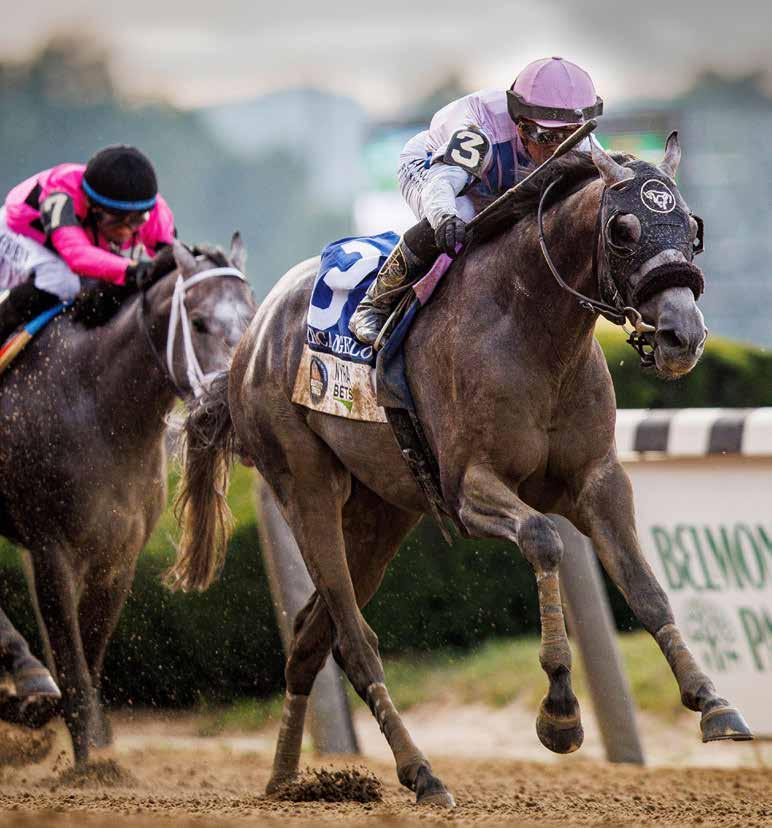
IT WAS AN HISTORIC END to this year’s US Triple Crown series on June 10 when trainer Jena Antonucci became the first woman to train a Belmont Stakes winner after Arcangelo (Arrogate) won the final leg of the series by a length and a half.


“When we were walking out, I said there is not a table made for you,” said Antonucci after the race. “You make the table. You put great people around you, you work hard. Work your tail off. It will come if you do it the right way. Do it the right way.”
Arcangelo’s win was another reminder of the loss when Arrogate died in 2020 after just three seasons of stud.
He has quickly become the most successful sire son of Unbridled’s Song – his first crop including the Grade 1-winning duo Secret Oath, winner of the Kentucky Oaks (G1), and the La Brea (G1) winner Fun To Dream.
His second crop has yielded three Grade 1 winners with the Belmont winner joined by dual Grade 1-winning juvenile Cave Rock and Del Mar Debutante (G1) winner And Tell Me Nolies.
Luckily for breeders, Arrogate has sired top level colts so there will be opportunities to access his line through one of those sons.
There is still one crop of juveniles left for Arrogate with the stallion breeding 139 mares before being pulled from stud duty shortly before his death with 106 live foals resulting from those matings.
Tapit and the Belmont Stakes have been tied together with unbreakable rope over the last decade and this year was no different.
Tapit was the sire of two of the nine runners in the race, but his influence went much further as he was also the broodmare sire of four other runners in the race.
Not surprisingly with those numbers, he played a part in the winner’s pedigree as the sire of Arcangelo’s dam, while also the sire of Belmont Stakes third Tapit Trice, who represented him in the Kentucky Derby.
Many of the US’s top stallions are approaching pension age, but the breeding industry looks to be in good hands as the rising superstars make an impact in the big races.
Freshman sire Good Magic made it clear he’s going to be a stallion for the future when Mage won the Kentucky Derby (G1) before
taking third in the Preakness Stakes (G1).
It is a tough group of sires that also includes Bold D’Oro and Justify, but Good Magic with nine stakes winners and six graded stakes winners, led by two Grade 1 winners, is currently doing best of the group.
Standing alongside his sire at Hill ‘n’ Dale, Good Magic had two runners in the Kentucky Derby and three in the Preakness Stakes – with two of those finishing in the top three. The Belmont Stakes was the only Triple Crown race in which the stallion wasn’t represented by at least one runner.
Good Magic’s sire Curlin has sired Classic placers in six of his 11 crops of three-year-olds but hasn’t had the luck the last two years. His supporters can’t be too disappointed, however, as Curlin’s sons have sired the last two Kentucky Derby winners.
Quality Road made sure the younger generation didn’t totally control the Triple Crown, his son National Treasure won the Preakness Stakes (G1) relegating Good Magic sons to second and third.
Now a 17-year-old, Quality Road is enjoying a banner year with 10 stakes winners and 19 stakes performers led by eight graded stakes performers.
Quality Road’s results have spanned more than just North America – his son Emblem Road winning the Saudi Cup and finishing third in the Dubai World Cup (G1).
In Europe he is also the sire of Patton Stakes (L) winner and Irish 2,000 Guineas
And Jena Antonucci becomes the first female to train the winner of the Belmont Stakes, writes Melissa Bauer-HerzogBelmont Stakes winning owner Jon Ebbert with his trainer Jena Antonucci
(G1) second Cairo showing that the son of Elusive Quality is far from a Dirt-only sire.
While Good Magic is yet to have any runners out of Quality Road mares, Quality Road bred to mares by Curlin could be a cross to keep an eye on, the five runners bred on the cross include a stakes winner and stakes placed runners.

THIS YEAR’S Triple Crown undercard also featured arguably the best horse in the older male division in Cody’s Wish (Curlin).
A Godolphin homebred, Cody’s Wish has bought horseracing into the mainstream media through the past year and his bond with Cody Dorman after the two came across each other after he toured Godolphin on his Make A Wish experience.
The horse was named after his new friend and is now one of the most popular horses in the US.
The horse Dorman credits for saving his life continues to hold up his part of the bargain on the track.
Cody’s Wish had not run since his Breeders’ Cup Dirt Mile (G1) win, but made a successful reappearance in the Churchill
Downs Stakes (G1) when romping home by over 4l for a third straight Grade 1 victory.
He added more drama to his story on the Belmont Stakes undercard. Despite running into plenty of trouble in the Metropolitan Handicap (G1), he showed his special talent bursting away from the field to win by three and a quarter lengths for a sixth straight win.
The four-year-old is the latest phenomenon from the Curlin x A.P. Indy sire line cross that has been so prolific.
He is one of three stakes winners for Curlin out of Tapit mares, while A.P. Indy daughters have produced 11 stakes winners and 22 stakes performers, led by the top
mares Malathaat and Nest.
A.P. Indy granddaughters are also the dams of 11 stakes winners and 19 stakes performers by Curlin, led by three Grade 1 winners.
Almost exactly five years to the day after he remained undefeated with his Belmont Stakes victory, Triple Crown winner Justify earned his first Grade 1 winner on the Belmont Stakes undercard.
His son Arabian Lion, who was originally aimed at the Triple Crown, rerouted to sprint distances instead of running in any of the Classics and the decision paid off for connections in spades.
Stepping up to Grade 1 level for the first time in the Woody Stephens Stakes (G1), Arabian Lion took off to win by a length and thee-quarters.

He is the second Grade 1 performer in as many weeks for breeder Bonne Chance Farm, also the breeder of the previous week’s Epsom Derby (G1) second King Of Steel.
Arabian Lion becomes the second straight Coolmore America-sired winner of the Woody Stephens after Jack Christopher won the race by 10l last term.
Justify is slated to take the champion Australian freshman sire honours this year, and will be the first northern hemisphere shuttler to achieve the feat since More Than Ready.
In all, Justify has 11 stakes winners worldwide led by seven graded stakes winners coming in three different countries. Justify’s studmate and fellow Triple Crown winner American Pharaoh registered his seventh Grade 1 winner when Marketsegmentation won the New York Stakes (G1) on the Turf.
She is the sire’s fourth Grade 1 winner on the Turf. He is the sire of 70 stakes performers worldwide overall with 36 winning stakes and 22 finding success at the graded stakes level.
Marketsegmentation is out of Lonelily, a mare by Medaglia D’Oro, and one of three Grade 1 winners for American Pharaoh out of Sadler’s Well’s lined mares.
That cross has proven to be an excellent one for the American-based stallion with his 49 runners including 36 winners, led by four graded stakes winners, six stakes winners, and 10 stakes performers.
Justify has 11 stakes winners worldwide led by seven graded stakes winners coming in three different countriesFan favourite Cody’s Wish (Curlin) taking his ninth race victory, and fourth Grade 1 in succession
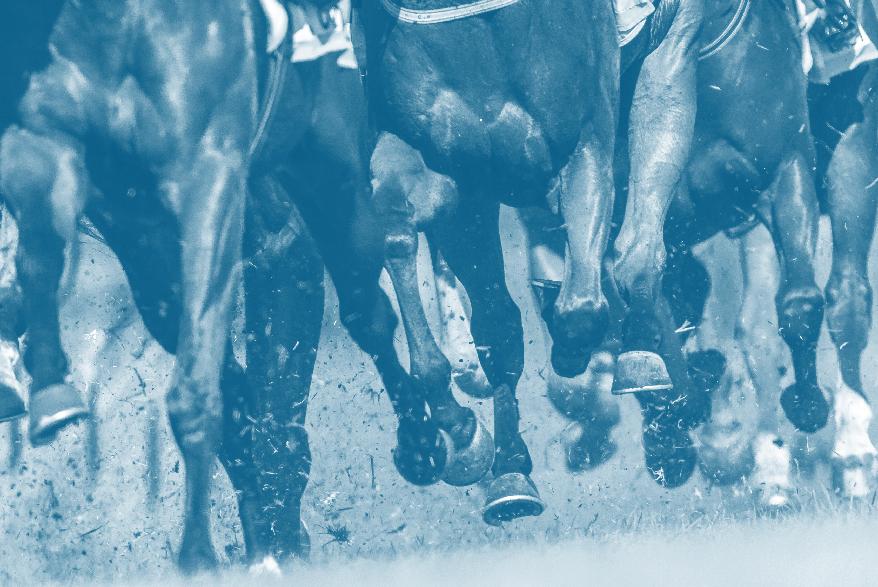
that year’s Timeform top-rated three-year-old filly
THE SAYING that “A racehorse is the only animal that can take several thousand people for a ride at the same time” could certainly have applied to one trans-Atlantic leading lady, the US-bred racehorse and producer Dahlia.
A finely built chestnut mare with a white blaze, Dahlia was born in the spring of 1970 from the union between the Prix de l’Arc de Triomphe winner Vaguely Noble and the stakes winner Charming Alibi (Honeys Alibi), who won 16 times.
Dahlia was inbred 4x5x4 to the great British champion Hyperion (Gainsborough), who excelled as a two-year-old in 1932 before going on to win the Epsom Derby and St Leger, and who later became a superior sire.
Dahlia’s tail-female line traced back to Family 13-c through Stray Shot, who was born in 1872 and was by Toxophilite. From her descended such racing notables as Tourbillon, Seattle Slew, Lomond, Mr Prospector, Darshaan and Sinndar.
Dahlia was a full-sister to the stakes winners Very Charming and Captain General and one of her half-sisters Golden Alibi (Empery) joined the Juddmonte broodmare band and eventually became the third dam of multiple French Group 1 winner and 2006 champion Rail Link.
A hardy sort with a great turn of foot Dahlia, who was also said to have been blessed with an amicable temperament, was bred by Nelson Bunker Hunt.
The owner had a colourful history. Born in 1926 to an Arkansas oil family, he grew fabulously wealthy from his oil and mining ventures. His attempts, alongside his brothers Lamar and William, to annex
the silver market in the 1970s resulted in heavy fines, bans and eventual bankruptcy.
Hunt also dabbled in racehorses. His picks included Dahlia’s sire Vaguely Noble, the 1976 Epsom Derby winner Empery and the tragically ill-fated US Racing Hall of Fame inductee Exceller.
Hunt won numerous ownership accolades in both Britain and the US.

Dahlia was shipped from the US to France to begin her career with the Egyptian-born trainer Maurice Zilber, also recognised for fielding Exceller, Empery and the subsequent US Eclipse champions – Youth, the male Turf horse of 1976, and Trillion, who was the female Turf horse of 1979.
Dahlia first set foot on a racecourse as a juvenile at two in 1972 giving no real hint of what was to come. She won the 5f Prix Yacowlef at Deauville on debut, but then finished unplaced in her next two starts before taking the runner-up spot in the Prix des Réservoirs (G3) over a mile at Longchamp.
The following year was very different and the filly quickly rose through the ranks to become a superb middle-distance performer, winning six times that season.
Against females she won the Prix de la Grotte (G3), a trial for the Poule d’Essai des Pouliches (G1), the Prix Saint-Alary (G1) by a length-and-a-half from the previously unbeaten Virunga, and the Irish Oaks (G1) by 3l from 1,000 Guineas and Oaks winner Mysterious.
She then faced the males for the first time in the King George VI and Queen Elizabeth Stakes (G1), and after weaving through from behind, she lowered the colours of the future Prix de l’Arc de Triomphe winner Rheingold, “striding away in tremendous
Dahlia’s King George double at Ascot remained an unbroken feat until Swain’s achievements in 1997-98
style” to win by 6l.
Only Mill Reef two years before had won the same race by such a margin.
A thorough grass specialist, who excelled on firm ground, Dahlia would meet her nemesis, the great Allez France, twice in 1973. She suffered the first two of several defeats to her in the Pouliches and in the Prix de Diane and, between her globetrotting wins in the Prix Niel (G3) and Washington D.C. International (G1), when down the field in the Arc, Allez France then second to Rheingold.
Unfortunately Dahlia did not get the chance to take on Secretariat when she won the Washington D.C., the US champion was retired after the Canadian International. Zilber had been convinced that his filly could mix it with him on the fast ground.
Dahlia kicked off her 1974 campaign with two defeats to Allez France in the Prix d’Harcourt (G2) and Prix Ganay (G1) before shipping to England for the Coronation Cup (G1).
Timeform reported that Dahlia’s jockey gave her a “preposterous task” as she toiled down the field early on before eventually finishing third. She bounced back to win the 1m4f Grand Prix de Saint-Cloud (G1) in France under more prominent tactics by a neck from On My Way and three weeks later she tackled the King George VI and Queen Elizabeth Stakes for the second time, partnered by Lester Piggott.
AFTER BEING SENT OFF as favourite against the Queen’s filly Highclere (Allez France having been withdrawn), Dahlia cruised along stands’ side, hitting the front before the last furlong, and went away from Highclere by two-and-a-half lengths.
Timeform remarked that Dahlia had “cantered home on the bit, without Piggott having to move a muscle.”
Dahlia’s King George double at Ascot remained an unbroken feat until Swain’s achievements in 1997/8.
Dahlia returned to England later in the summer as favourite to win the 1m2f Benson and Hedges Gold Cup (G1) at York, and she duly complied, with Highclere once again left in her wake. Partnered by Piggott, Dahlia met some difficulty in the straight before grabbing the lead over a furlong from home to win by two-and-a-half lengths from Imperial Prince. She ended a fine year by swerving the Prix de l’Arc de Triomphe (G1) to aim at a trio of high-profile
Piggott rode his 3001st winner on Dahlia when the pair won the 1974 renewal of the King George Vl and Queen Elizabeth Stakes
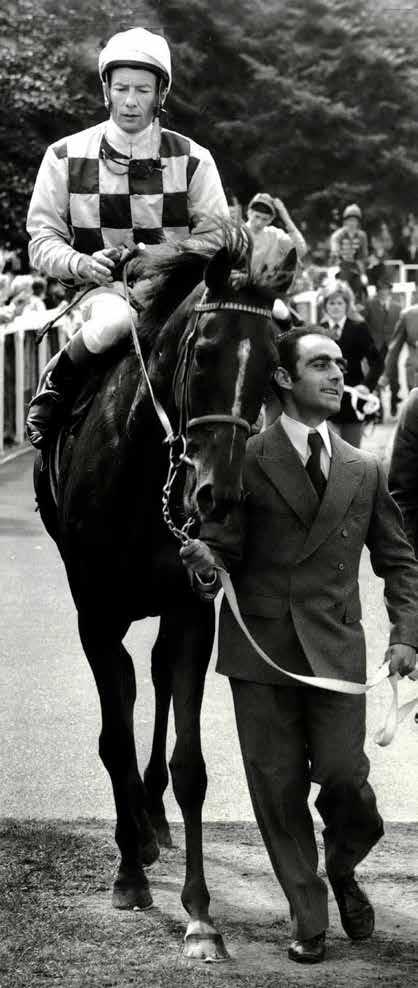
North American races.
1972 Prix Yacowlef
1973
Prix de la Grotte
Prix Saint-Alary
Irish Oaks
King George VI and Queen Elizabeth Stakes
Prix Niel
Washington, D.C.
International
1974
Grand Prix de Saint-Cloud
King George VI and Queen Elizabeth Stakes
Benson and Hedges Gold Cup
Man O' War Stakes
Canadian International Stakes
1975
Benson and Hedges Gold Cup
1976
Hollywood Invitational Handicap Awards
1973
Timeform top-rated 3yo filly
Top-rated 3yo filly in Britain
British Horse of the Year
1974
British Horse of the Year
U.S. Champion Turf Horse
Timeform rating: 135
First came the Man O’ War Stakes (G1) at Belmont Park over 1m1f in October. Zilber felt that Dahlia was lacking condition due to her US quarantine, and jockey Ron Turcotte took over from Piggott, who had been felled by an ear infection.
Despite those disadvantages, Dahlia won by 2l coming from well off the pace with Crafty Khale second.
Turcotte said: “She did what she was supposed to do all by herself... I never touched her.”
She was reunited with Piggott for the Canadian International Stakes (G1) at Woodbine, and after hugging the rail, Dahlia powered through a window of horses to lead in the straight, denying Big Spruce by a length in a track record time of 2:40.00.
Piggott reported that despite being boxed in “I felt I had no cause for concern. I knew Dahlia had lots to give...”
Finally, starting as favourite for a replay of her Washington D.C. International success Dahlia was forced to the outside on the last turn and trailed the leaders by 6l. Unable to sustain her challenge she could only finish third behind Admetus and Desert Vixen.
Later Piggott batted away US media critics: “They can’t win all the time, they’re not machines, you know!”

In 1975, Dahlia again worked up to better things as the season progressed. A thorough drubbing to Allez France in the Ganay preceded more unplaced efforts in France and Italy.
She was somewhat worked up before her third tilt at the King George VI and Queen Elizabeth Stakes, but still finished a creditable third behind that legendary dual between Grundy and Bustino.
on Grundy in the Benson and Hedges Gold Cup at York in producing her seasonal best with Piggott aboard. She made all and led home a French-trained one-two, holding Card King off with Grundy in fourth.
Back in France, she placed in the Grand Prix de Deauville (G2) and Prix du Prince d’Orange (G3) prior to her final European race in the Arc in which she
Owner-breeder
Nelson Bunker Hunt
squared up against Allez France for the last time. Sadly, she finishing well down the field after stumbling.
Dahlia’s rivalry with Allez France is especially noteworthy.
Hunt had rejected the latter US-bred filly as a yearling as he did not care for her sire Sea Bird.
She was instead bought by French art dealer Daniel Wildenstein, who would in time name his American racing operations after her.
Allez France went go on to achieve Timeform’s joint-highest rating for a European female at 136.
Dahlia competed against and lost to her greatest rival all six starts in her career from the Pouliches in 1973 to the 1975 renewal of the Ganay when Dahlia came home last of the six runners, before meeting Allez France for the sixth and final time in the Arc.
Dahlia’s last year to race in 1976 saw her confined to California in the care of the Hall of Fame trainer
experts as among their top highweights, and she was later inducted into the US National Museum of Hall of Fame in 1981 and the Canadian Horse Racing Hall of Fame in 2016.
In Britain, Timeform gave her a maximum rating of 135, and she was the company’s top-rated three-year-old filly of 1973, as well as being named British Horse of the Year in 1973 and 1974.
Additionally, she was voted Irish champion three-year-old filly of 1973.
In comparing Dahlia with Allez France, it could be argued that, as exceptional as the latter was, the vast bulk of her racing was within France, while Dahlia excelled in regularly bouncing back and forth between Europe and North America, including in between defeats to her rival, and clearly enduring far more gruelling travel.
It has also been surmised that the softer racing ground in France was a mitigating factor in Allez France’s victories over Dahlia.
Dahlia achieved several firsts.
She was the first horse to win Group/Grade 1 races in five countries.
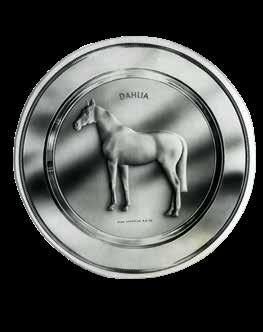
Sports Illustrated magazine and the National Museum of Racing both credited her with being the first female thoroughbred to reach a million dollars in US earnings, and she was also the first filly to win the Washington D. C. International Stakes.
In 1988, Hunt sold his racing operations and Dahlia was purchased for $1.1 million by American owner/breeder Allen E. Paulson.

She was undeniably a better broodmare than her rival getting eight winners from 13 named foals, including the Group/Grade 1 winners Dahar and Rivlia, who repeated the feat of their dam with victories in Europe and the US.
She also produced the Grade 1 winner Delegant and the Grand Prix d’Evry (G2) winner Wajd, dam of 1998 St. Leger winner Nedawi.
Her non-winning daughter Dahlia’s Image is grand-dam of the recently deceased Rite Of Passage, winner of the Ascot Gold Cup (G1) for trainer Dermot Weld and owner Dr Lambe.
For these and others, Dahlia was awarded a Reign de Course accolade by respected pedigree analyst Ellen Parker. She had numerous races named in her honour, including the 1m1f Dahlia Stakes (G2) at Newmarket and the 1m2f Prix Dahlia at Saint-Cloud (L), for fillies and mares.
Her remarkable lifetime record stood at 15 wins, three seconds and seven thirds from a total of 48 starts, and with $1,543,139 in US earnings (including foreign conversions). She died in Kentucky at the grand old age of 31 and she is still remembered as one of the greatest female thoroughbreds to have ever lived.

They can’t win all the time, they’re not machines, you know!A silver-gilt plate, designed by John Skeaping, of Dahlia presented to Bunker Hunt at Ascot in 1974. The presentation was made in the unsaddling enclosure by racehorse owner Mr. Jim Joel
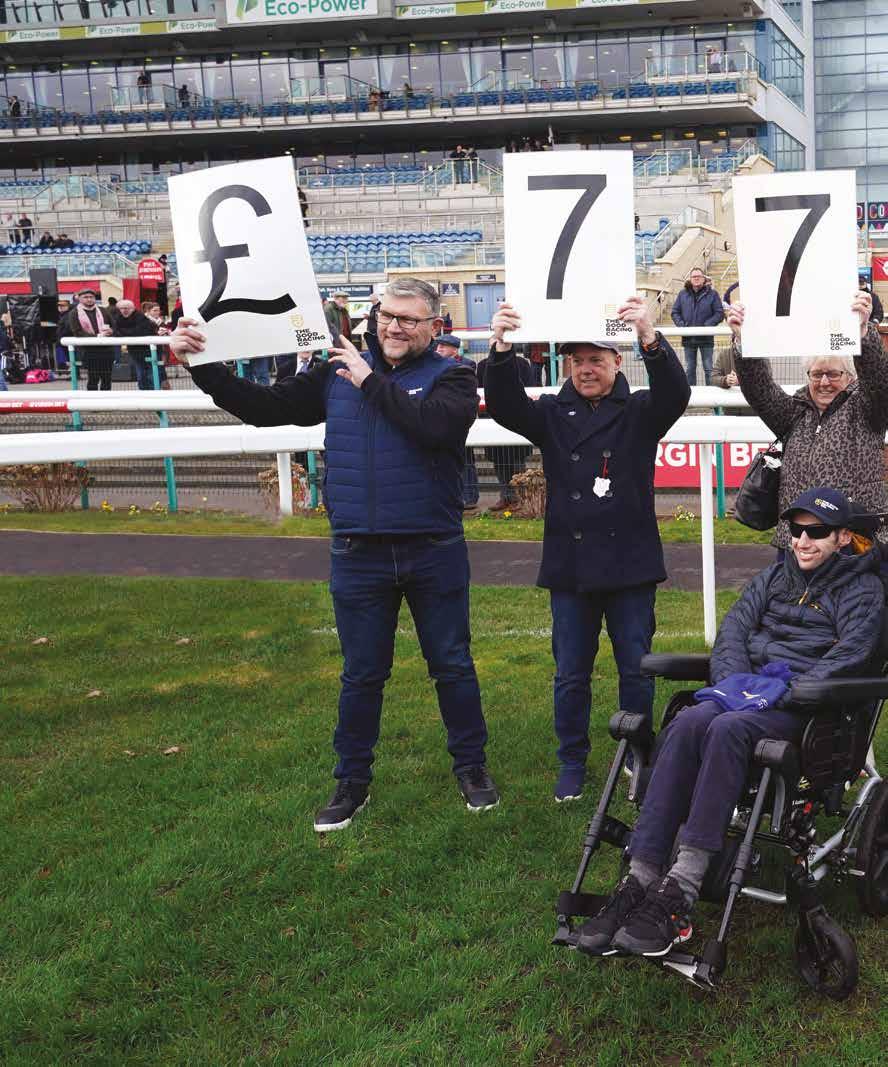
The Good Racing Company donated £77,777 to the Rob Burrow Discretionary Trust and the MND Association at Doncaster on February 22 The ex-rugby league star player Rob Burrow in the centre of the shot

 James Thomas chats with Phil Hawthorne of The Good Racing Company, the racing club that sends all of its profits to charity
James Thomas chats with Phil Hawthorne of The Good Racing Company, the racing club that sends all of its profits to charity
is no ordinary ownership group. With all profits the club generates going directly to charity, this is less horses for courses and more horses for causes.
The concept, the brainchild of Phil Hawthorne, began with the Burrow Seven Racing Club, which was set up in honour of rugby league legend Rob Burrow. The former England and Leeds Rhinos star, who wore the number seven jersey throughout a career littered with iconic moments, was diagnosed with motor neurone disease (MND) in December 2019, prompting his equine namesake to be paired with the MND Association.
The initiative proved so successful that Hawthorne has broadened his horizons, with other racehorses being paired with various
worthy causes under The Good Racing Company banner. Much-needed funds have been raised while members get to enjoy the ownership experience at an affordable entry point.
Hawthorne, 65, has been a life-long racing fan having first visited his local course during a bygone era of steeplechasing celebrities.
“My first recollection of racing is my father taking me to Haydock Park when we lived in Wigan, I was about ten or 11,” he says. “I remember getting hooked on the sights, the sounds, it was just great.
“Even though I never saw him in the flesh, I was always told about a horse called Flyingbolt. My dad had a strong opinion, which I know Ted Walsh shares, that he was actually better than Arkle – as controversial as that is!”
The qualified accountant has since owned
shares in various syndicates and nominates the victories of the Nick Williams-trained Theocritus and the John Upson-trained Agincourt as the standout moments, albeit the latter’s Wetherby win back in 2001 so nearly ended in disaster.
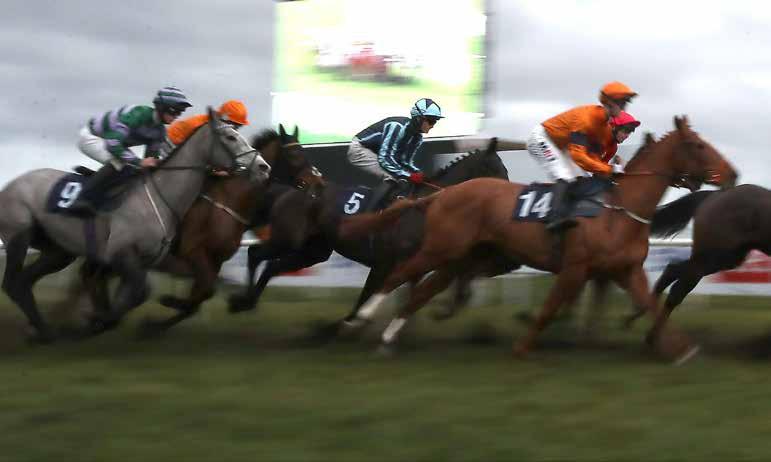
“The day Agincourt won at Wetherby was quite an event,” he recalls. “It was a bit unexpected as he was a 25-1 outsider under a jockey called Marvin Mello. I ran off to greet him into the winners’ enclosure and popped a calf muscle and ended up in intensive care with suspected deep vein thrombosis!”
Thankfully the origins of the Burrow Seven Racing Club proved much less dramatic. Hawthorne explains that the idea came to him following a chat with his friend and Sky Sports rugby league pundit Barrie McDermott, a former teammate of Burrow during their Leeds Rhinos days.
“I’ve got a little bar in my house and I
was sitting there having a glass of wine and listening to racing podcasts,” he says. “I’d been speaking to Barrie McDermott and we were having a chat about life, and when we put the phone down was when I thought why can’t we put together a racing club to help Rob and MND?”
Hawthorne had the idea but now needed the horse. Next came a call to renowned pinhooker Mark Dwyer, who had been sponsored by a business Hawthorne was involved in during his days as a NH jockey. The Cheltenham Gold Cup-winning rider pointed his associate in the direction of Henrietta Knight, who in turn recommended a well-bred son of Kayf Tara. He became known as Burrow Seven.
Identifying a suitable trainer was another crucial part of the process, but Dwyer knew just the man for the job.
“Mark described Jedd O’Keeffe as a
really good bloke who’s open and honest,” says Hawthorne. “I didn’t know what kind of reaction we’d get [when we launched] but I did know that, at least to start with, we needed a trainer who’d be receptive to interviews, the media, open days and TV cameras.
“I went along to see Jedd and when we were sitting in his kitchen having a cup of coffee and explaining the idea, I think he and his wife Andrea thought I was going mad! Within a matter of months we’d pulled it off though and Jedd and Andrea and their team played a big part in that. They’ve been brilliant.”
The racing club opened for business in late-2020, back when Britain was in the thick of Covid-19 lockdown. Annual membership was offered at just £59. The response was immediate.

“We’d hoped for some reaction but the positivity behind the idea was absolutely huge,” says Hawthorne. “It was during lockdown and people were looking for something to get involved with while they couldn’t go out. I sold the club on the basis that it was inclusive and that it would support MND and it was, at the time, Covid

We’d hoped for some reaction but the positivity behind the idea was absolutely huge

“Since making the change to Connolly’s RED MILLS and using Horse Care 14 Mix, my horses are looking and feeling great. Our horses are eating and working well and recovering quickly after running. It’s great having the support of their team which means a lot. To have a Group 1 winner at Royal Ascot was fantastic, and we’re delighted for all the team who work so hard for days like that.”

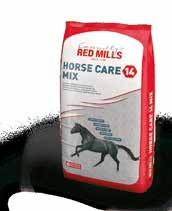
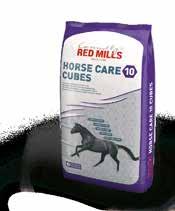
KHAADEM
To all RED MILLS Customers at Royal Ascot. 51% of all winners at Royal Ascot fed on Connolly’s RED MILLS
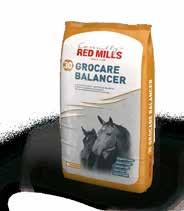
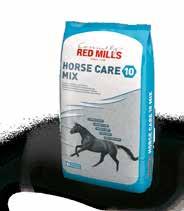
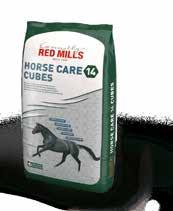


friendly because people could get involved without having to leave their lounge.
“The timing was good but I think the concept was a bit different too, especially with the links to the rugby league and MND communities. But I didn’t expect the reception we got. People such as Barrie McDermott and other ambassadors got onboard and were sharing our stuff on social media. That aspect was especially strong. Guys like Graham Lee, Paul Hanagan, Niall Hannity and Paul Mulrennan, whatever they could do, they did.”
Once the word was out members signed up from far and wide. Other racing stables were so struck with the idea that Hawthorne says “nearly everyone” in Middleham signed up, while new members got on board from as far afield as Australia and New Zealand, China and North America. Individual members were joined by over 40 businesses, who signed up at a cost of £777.
Burrow Seven’s racing career gave the club’s members plenty of excitement along the way, most notably when he finished runner-up at Wetherby in his second bumper outing and when third at Carlisle
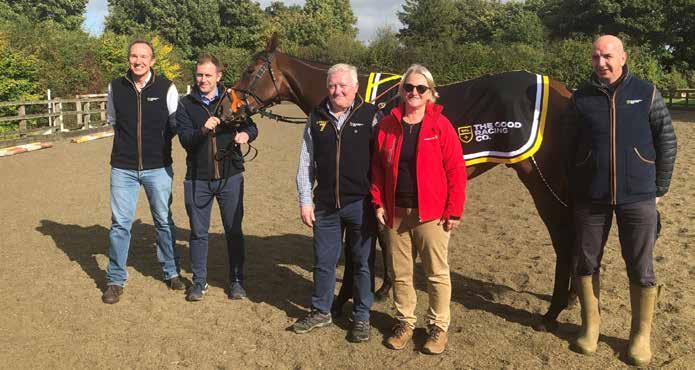
The profits raised from membership sales in each horse are donated to the partnered good causes – the money raised from Beep Beep Burrow goes to the The Rob Burrow 7 Discretionary Trust and The MND Association; and for Go Go Chicago it is split between Racing Welfare and Racing to School.
All the profits from membership and sales including race winnings are split between the horse’s partnered good causes.
Whether the horse wins, loses (or dead heats!), all profits go to the dedicated causes
on his second run over hurdles. However, Hawthorne highlights that the club’s biggest and best results have been away from the racecourse.
To date the Burrow Seven venture and, latterly, The Good Racing Company have raised and donated an impressive £177,777 to the MND Association and the Rob Burrow 7 Personal Trust. Moreover, the club’s contribution goes much deeper than cold, hard cash.

Since Burrow’s diagnosis he has shared an unfiltered account of his journey, a selfless decision that has not only revealed his own superhuman resolve but helped bring awareness of MND to a much bigger audience.
He has been supported by another former teammate in Kevin Sinfield, who has helped to raise vital funds and awareness through a series of gruelling challenges such as seven marathons in seven days and running 101 miles in under 24 hours.
Thanks to the likes of Burrow, who was awarded an MBE for services to rugby and MND awareness, and Sinfield, the subject of MND has gained greater prominence among www.
the public consciousness.
Burrow Seven’s popularity is, at least in part, down to being a part of the wider conversation that is now taking place, which in turn has given people an opportunity to contribute in a meaningful way through the somewhat unlikely vehicle of horseracing.
“We’ve had some fantastic partners, great members and supporters,” says Hawthorne. “Everyone has got behind us. It’s not just the money though, it’s about the awareness too. If we’ve played a small part in raising awareness for MND then that’s great.
“Going back even three or four years ago I don’t think MND is something people would’ve known a great deal about. Obviously with all the brilliant work that Kevin Sinfield and others have done, MND awareness is now as big as it’s ever been.”
WHILE THE CLUB makes obvious appeal for fans of racing and rugby league, Hawthorne is particularly proud of the close association that has been formed with the MND community. Burrow, his family, and others living with MND have taken an active part in the racing journey, including on race day.
“To start with it was definitely rugby league fans before the racing audience picked it up,” says Hawthorne. “Then the MND community took it up and when Burrow Seven made his debut lots of people from that community were there. There’s been a lot of goodwill and support from the MND community.”
No racing venture is complete without a few ups and downs and unfortunately Burrow Seven sustained an injury that brought his time on the track to a premature end, although given the funds he has helped raise and goodwill generated it is arguable no four-race maiden has ever made a bigger impact. What’s more, an exciting new venture means he still has plenty to offer.
“We’ve obviously had more than our fair share of disappointments through injuries or poor performances but we’ve always managed to have a laugh at the end of the day,” says Hawthorne. “The club’s slogan is ‘Even when we lose, we win’ and we’ve done that because it’s still creating awareness and
it’s keeping MND in the public eye.”
The success of the initial Burrow Seven concept inspired Hawthorne to form The Good Racing Company. New horses were added and duly paired with other worthy
causes, while new recruit Beep Beep Burrow took Burrow Seven’s place at the O’Keeffe yard.
“My thinking was that if it could work for one kind of charity, in this case with MND, then it should be able to work for others,” he says. “Since the racing community had given a lot, we wanted to give something back.
“So we got another horse called Go Go Chicago with Fergal O’Brien and Graeme McPherson and the two charities we’re planning to support are Racing Welfare and John Blake’s Racing To School.”
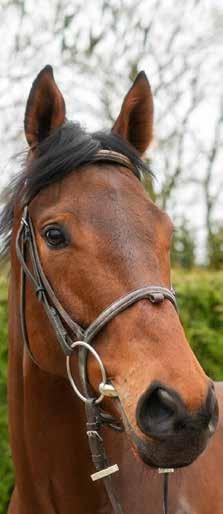
Hawthorne is also on the cusp of launching the Rob Burrow Racing Club, which will give members a 360 degree ownership experience with a NH runner in Beep Beep Burrow, newly recruited Flat performer Family Ties and the old favourite Burrow Seven, who has begun a second career as an equine welfare horse with the retraining charity New Beginnings.
As ever, members will be encouraged to join the journey with stable visits, trips to the races as well as following Burrow Seven now that his racing days are behind him, all while contributing to a good cause.
At a time when attracting and retaining new fans and owners represents a major challenge, the efforts of The Good Racing Company prove what can be achieved by thinking outside of the sport’s usual confines. Moreover, the kind of positive approach taken by Hawthorne also strikes as exactly what is required as the thoroughbred industry strives to shore up its social licence.

“That’s something that I’d definitely like to build on by having a chat with the jockeys, trainers, administrators and asking how we can maximise the exposure of the sport,” he says. “There’s so many good news stories out there, so let’s tell them.”
While Hawthorne can feel no shortage of pride at what he and his associates have achieved in such a relatively short time, he already seems laser focussed on what lies ahead.
“This has always been part of a subconscious plan,” he says, reflecting on the success of his racing ventures. “Now we’ve been able to enact that plan, I’d like to think the progress in the next 12 months will be even swifter in the last 12.”
Watch this space.
My thinking was that if it could work for one kind of charity, in this case with MND, then it should be able to work for others

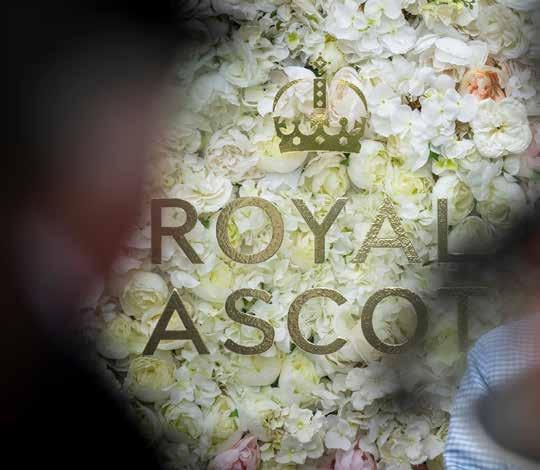
BRADSELL

KING’S STAND STAKES, Group 1 sold Tattersalls Somerville Yearling Sale by Bearstone Stud to Highflyer / H Dunlop for 12,000 gns
KHAADEM
QUEEN ELIZABETH II JUBILEE STAKES, Group 1 sold Tattersalls October Yearling Sale, Book 1 by Yeomanstown Stud to Shadwell Estate Company for 750,000 gns
RIVER TIBER
COVENTRY STAKES, Group 2 sold Tattersalls October Yearling Sale, Book 1 by Pier House Stud to M V Magnier & White Birch Farm for 480,000 gns
ROGUE MILLENNIUM
DUKE OF CAMBRIDGE STAKES, Group 2 sold Tattersalls December Mares Sale by Shadwell Estate Company to J S Bloodstock for 35,000 gns
JIMI HENDRIX
ROYAL HUNT CUP, Heritage Handicap sold Tattersalls October Yearling Sale, Book 1 by Ballylinch Stud to A C Elliott, Agent / R Beckett for 82,000 gns
AGE OF KINGS
JERSEY STAKES, Group 3 sold Tattersalls October Yearling Sale, Book 1 by Corduff Stud to M V Magnier & White Birch Farm for 1,100,000 gns
BIG EVS
WINDSOR CASTLE STAKES, Listed sold Tattersalls October Yearling Sale, Book 2 by Houghton Bloodstock to Michael Cleere for 50,000 gns
DOCKLANDS
BRITANNIA STAKES, Heritage Handicap sold Tattersalls Ireland September Yearling Sale by Clenagh Castle Stud to Blandford Bloodstock for £16,000
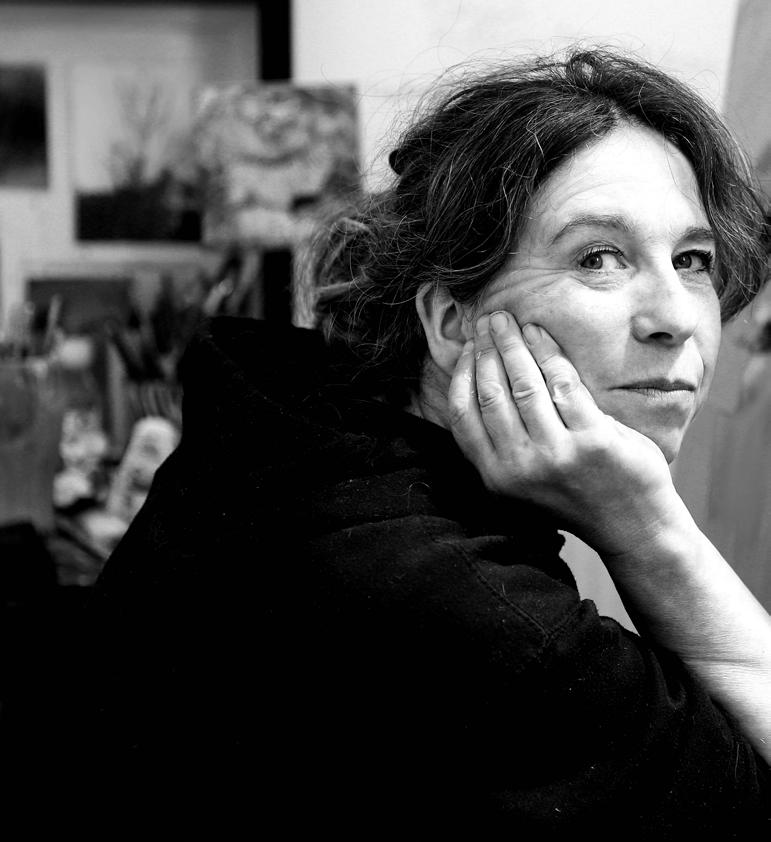
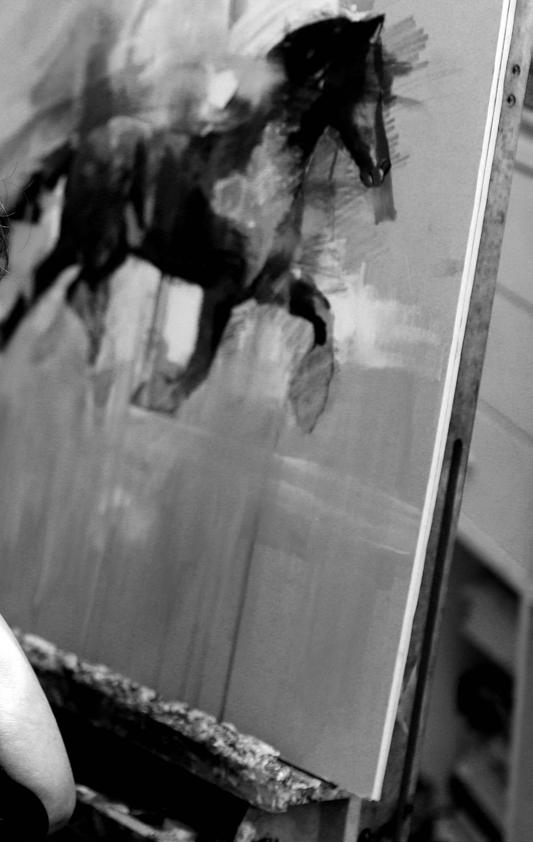
Instagram: annabelartist
facebook: annabelartist
www.annabelthornton.co.uk
DOWN A LITTLE WINDY ROAD, over the humped back bridge that crosses the River Weaver, and away from the main thoroughfare that takes drivers to Audlem in Cheshire, enquiring visitors will find the equine, wildlife and landscape artist Annabel Thornton.
She lives in a fairy story of a house, and tucked out the back in the peace and quiet to allow creativity, is her studio and gallery; and this is where her magic happens and where the artist, who recently won the prestigious David Shepherd Wildlife Artists Editor’s Choice Award for “Lone Bee”, can let her mind and artistic talents wander free.
Thornton featured on the front cover for our December issue with her striking image of “Finish Line” and we promise all our front cover artists an interview in the June-July issue in return for the use of their images.
We definitely end up on the best side of the deal, and this spring we combined an onward journey to Chester for Cup day with a visit to meet Thornton. Taking in a day’s racing with the opportunity to view wonderful pieces of art seemed a highly attractive day out. We were not disappointed – on arrival at 20, Salford we were transported to a world of equines, wildlife, dancers, colour and creativity.
We meet the equestrian, wildlife and landscape artist Annabel Thornton, who explains how she lets her work take its own path
Thornton, understated and almost surprised by the quality of her work, showed us around her one-person studio which is, as to be expected for such a busy artist with a broad remit, full of her own work in progress (very few finished pieces, they are all sold)
as well as bits and pieces she has collected, including art, sculpture, knicks and knacks.
“I adore sculpture, and I like unusual things, I have odd things around, I like collecting,” she admits.
The studio is very much Thornton’s happy
place and the artist spends most of her days and working hours ensconced in the room with her dogs and preferred sounds playing, which are selected daily from a play list that she writes on the wall.
“I like to get into here,” she adds. “I get the music on, the dogs are permanently with me asleep on the floor and I then just paint. I go from the house to the studio and I don’t have to worry about my appearance for work – I am always covered in paint, I have paint in my hair most of the time!”
The paint was absent for our visit as she was out of her work attire, but the urge she has for her work still radiates: “I am very lucky to do something that I love and a subject matter that I love, I am passionate about wildlife and animals.”
MANY OF HER PAINTINGS are full of colour and fun, but there is also a unique and evocative set of black and white monochrome works. She enjoys the use of texture and when chatting as to how she finds the inspiration for her approach, you get the feeling Thornton just works very instinctively, letting the painting evolve as the image develops. Conforming to a form or a style or a plan is not something on the Thornton repertoire.
“I set out with an idea in my head,” she admits, then laughs, “but it never ends up like that because I always change things! If I don’t like something, such as a line, then I’ll move it. I’ll change things all the time, and then sometimes if a painting is still here, I’ll go back again and alter it again.
“With the black and white pieces, I am just trying to capture peace and serenity and the calmness of horses. I start with the
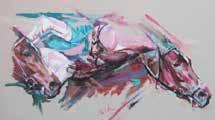
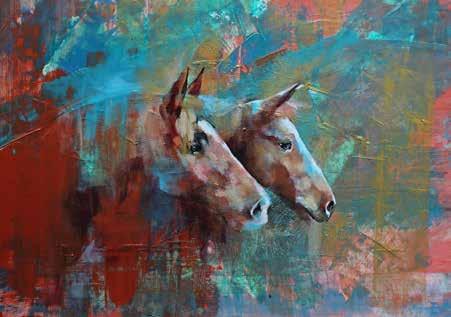

monochrome, but then might add a flash of colour.
“With the coloured images, I just have this feeling – I might add layers and then I might take all layers off again!”
Of the techniques she explains: “I tend to I use acrylics and oils, but I like using pencil with the pieces as well and work within the paint. It means you get some texture. I love texture and I love pattern, as well. And I like adding a strong colour, a real bold colour, perhaps a colour that viewers would not expect,” and with a cheeky grin, she adds: “And I just love adding in a bit of gold!”
She never lets herself get too carried away with the bling: “For some of the pieces it is kept subtle; it is just all about trying to capture that moment, whatever I am trying to get across with the painting and the feeling.
“With the works focused on movement, I will use a lot of flicks of the paint to create speed; I will use differing techniques with whatever I am trying to create. I think it is probably very instinctive, and I just know what I want to do once I start. I go with the flow.”
While racing and painting of thoroughbred is a relatively new part of Thornton’s life and work, horses have always
been a mainstay, her grandparents and her parents had horses and she rode from a young age. She has a mix of five ponies and horses at home and her 13-year-old daughter Eesha is out every day and at weekends competing.
Thornton believes that her equine background and day to day involvement has been integral in her ability to paint horses, giving her innate knowledge to form the basis of her work.
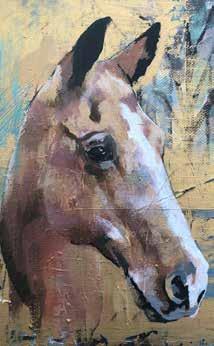
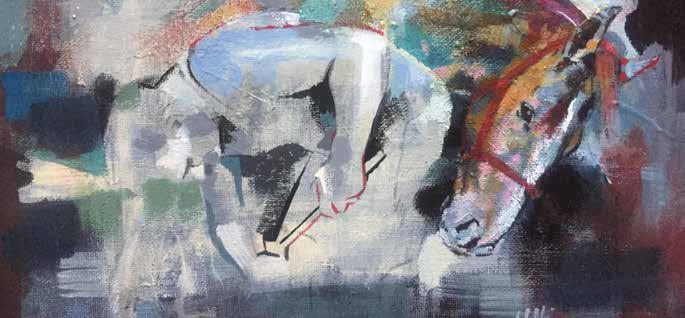
“I think because I ride and we have the horses, you have a feel for them, the movement and know just where the legs and body parts should be,” analyses the artist. “You are always looking and getting a feel for them. I have always been interested in nature and the human form. I like movement, I like horses and racing, I like the structure.”
Horseracing has always offered artists a rich seam, both creatively and financially, but there is still a hint of surprise in Thornton’s voice when she reports that, unsurprisingly, her thoroughbred work tends to sell “straight away”.
“I just love the way a thoroughbred moves,” she adds. “It’s just unbelievable. It is beautiful. Racehorses are so graceful, powerful but they are also so kind.
“That’s something I love about all horses that they have got that kindness to them. You can see why horses are being used for the ground-breaking work with mental health welfare, they are just so calm.”
Thornton, who was always passionate about art at school, gained her degree at the Cheltenham College of Art and since then has always been a self-employed artist, it is a job that works for her and pays its way. Her art is shown and sold in several galleries, but the digital world has seen many of her sales now coming direct via the world of Instagram and the online community; with a teenager in the house she has an immediate tech help line, Thornton admitting she is not the most proficient in the sphere of social media.
TO HELP FACILITATE these sales the artist has set up an inhouse gallery for any in-person visitors who make their way down her windy road, and it is very important to Thornton that her work is accessible and affordable for all. She rarely takes prints from her originals, keen that people can buy that unique piece of “real” art, that they can feel something tangible with their piece.
“I want to try and encourage more people to buy art and love art, and buy originals, too,” she says. “It’s nice if people can have an original rather than a print, it is a big difference. You get so much more from
knowing that it is the only piece created, that it’s got the paint marks, the artist’s touch, and I just think it’s lovely.’


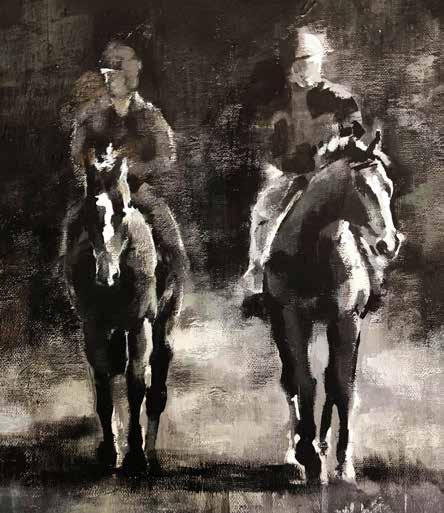
She admits she is always exploring new ways of “doing”, her work is constantly evolving; a viewing of her collection confirms a variety of styles and topics, and she feels that is currently taking a more “contemporary” slant.
“I want to cultivate my work all the time,” she explains, “I’m always looking to develop, I’m always looking to produce that next piece and to get something else and new from it, find an approach that I can take on to the next stage. If an artist is always open to new ideas, then work evolves and changes.”
She ponders a moment: “I suppose I might
It’s nice if people can have an original rather than a print, it is a big difference. You get so much more from knowing that it is the only piece created“Young Whippet”
“Morning Workout”
end up going back to very tight drawings, but I very much doubt it, I am too untidy for that and far too messy!”
She explains her current focus a bit further: “My work is becoming more contemporary; I like to be able to ‘suggest’ a movement rather than draw that movement – perhaps ‘suggest’ that a leg is there. That can be with a line or just via a movement in the paint.”
A“HINT” can’t be made without a real understanding of form.
“It is important to be able to know the structure, and to be able to draw that structure, and where the right position is for something, before being able to move on to more approach. Because you have a better feel, you should be able to know where the bits should be and can offer that ‘suggestion’.
“I think there’s always something I can do differently. That’s probably why I am developing a ‘looser’ approach. I think that once you feel as though you’ve reached the peak, then you’re not going to learn anything new.”
Although Thornton works in such a fabulous location, designed for the creative process, she does admit that sometimes she gets an artists’ block, and when that requires her to completely walk away.
“I don’t force it then,” she explains. “No, I leave the studio for the day, and I’ll do something else – I’ll do the garden or go and do the horses. And then I’ll come back to it. But once you’ve got artists’ block, it’s a horrible feeling, and it can last for days even weeks.
“I can then go to the extreme – I’ll remove much of the image and just leave some of it By fetching out some of the image, then I can see which bits I do and I don’t like. It is quite interesting way to approach a piece.”
Judging by the quantity and quality of superb pieces she has produced artists’ block must come rarely to the talented painter.
Thornton is keen to see where her work life artistic journey takes her, and while excited to see that happen, she is also prepared to let it unfold naturally and under its own direction, and let that path find its own, possibly winding, course.
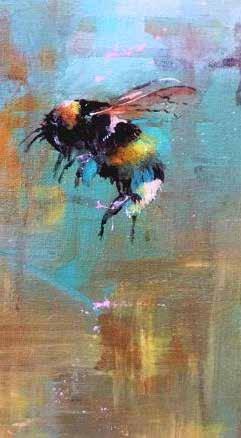
The 1930s Hollywood film industry loved horseracing and many of the stars owed horses, including the legendary Fred Astaire, who had racehorses in the UK and the US.
Letters sent by Astaire to his UK trainer Jack Leach were part of an online exhibition staged this spring by the National Horseracing Museum.
We trace the union between the US film industry and horseracing, and profile Astaire’s passion for the sport. With thanks to the National Horseracing Museum and the Cox Library

HOLLYWOOD STARS from the 1930s and today’s digital world collided and crossed generations in Newmarket this spring.
The National Horseracing Museum hosted an online exhibition of letters written by the legendary dancer and actor Fred Astaire to his UK-based racehorse trainer Jack Leach.
Astaire was a keen racing man, owned horses in training in the UK and the US and was fully part of the racing scene in both countries.
Leach’s grandson Andrew Gosling has a
collection of letters sent between the star and his trainer spanning the period between the 1930s to the 1950s, and loaded them to the museum for this online exhibition.
In some respects, it is no surprise that Astaire was a fan of horseracing and was actively involved – the 1930s Hollywood film industry and the racing world enjoyed a close association, with many of the stars as well as those working behind the scenes involved either as racehorse owners or keen racegoers, bettors, fans or just on track to be “seen”.

The two worked off each other and the sport then had a huge following in the US
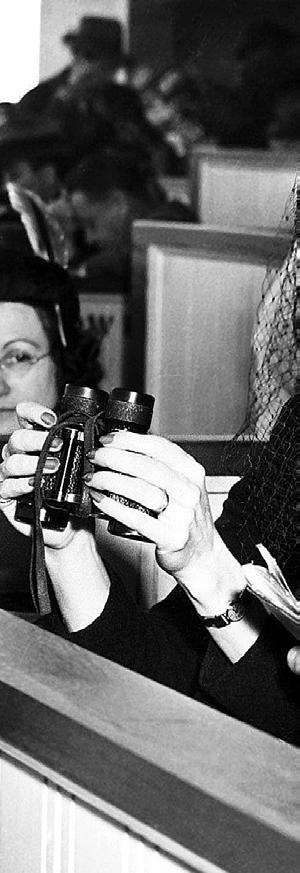

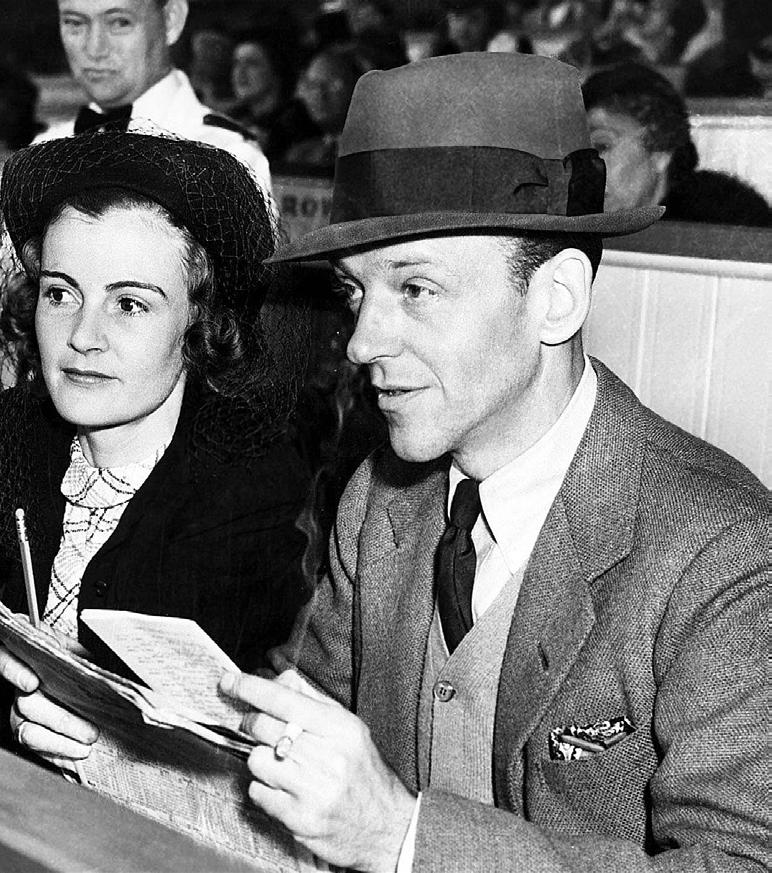
– horseracing and baseball dominated the sporting world and the racetrack provided rich content for the films of the day.

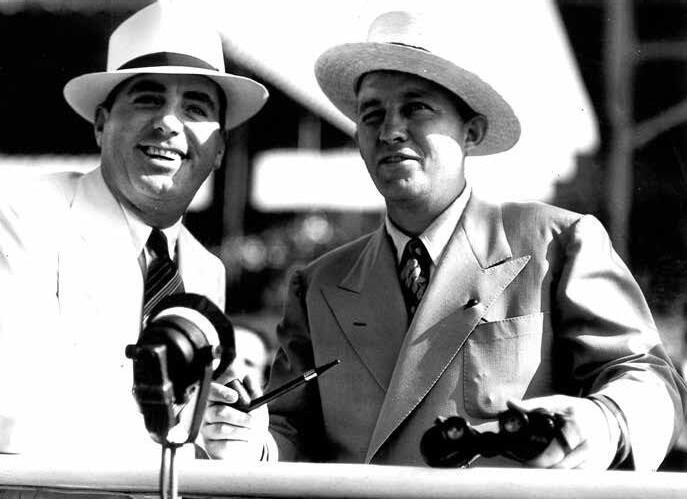
In the book “Hollywood at the Races: Film’s Love Affair with the Turf” author Alan Shuback writes: “A day at the races is as much a social occasion as a sporting event, and this was appreciated by the Hollywood film community.
“Actors are a sociable breed. They enjoy the camaraderie a racetrack can offer, be it in the stands, in the restaurant, or under the trees in one of the track’s gardens. Each way station at a racetrack – the paddock, the bar, the line at the betting windows, the winner’s circle – is an opportunity to greet friends, exchange opinions on the next race, or complain about the jockey’s horrible ride on the favorite in the previous race. To that extent, racetracks seemed purpose-built for Hollywood, where a good conversation – or a juicy piece of gossip – never went unheard. And of course, there was the betting. Anyone who worked regularly in Hollywood had reserves of cash that they were just itching to pour through the bookies.”

Racing in California had first really found its commercial feet in the early 1900s when businessman Lucky Baldwin opened a racetrack on his private ranch in Arcadia, about 20m east of Los Angeles, on December 7, 1907.
He called it Santa Anita, and business boomed for two winter seasons until 1909,
when California’s “moralising” middle-class put it out of business with laws outlawing gambling.
Things got even worse by the 1920s when prohibition had come into effect, set up to protect individuals and families from the “scourge of drunkenness.”
By the 1920s there had been an explosion in movie production and audience numbers, but the growing Hollywood crowd could not get to the races to have a drink and a bet.
It led to regular a weekend migration as the stars crossed the border to Mexico to find their find fun at the sports.
As Alan Shuback adds: “Sinfulness has its attractions, but when sin becomes illegal as well as immoral, incurring the wrath of the state as well as God, it becomes a bit too dangerous even for high-profile movie stars with big bankrolls and protectors in high places.
“You had all these rich, talented, sociable people who couldn’t get a legal drink, couldn’t put a legal bet down and had no
major league sports,” writes Shuback.

“So they went to Tijuana where there was horseracing, casino gambling, bars, restaurants and prostitutes – everything that movie stars liked.”
The 1930s Great Depression began to turn things back in the favour of the movie stars and horseracing as the local authorities needed to puts funds in the bank – a tax on betting was seen as an easy win, and the sport found a legal home north of the Mexican border again. The poorly run prohibition laws were also repealed in 1933.
A group of investors spent around $3 million on redeveloping Santa Anita to the state-of-the-art facility we still know today, and thrilled owners and racing fans everywhere by offering a $100,000 (around $7 million today) winner-take-all prize in its signature annual event, the Santa Anita Handicap.
The extravagant prizes drew in the horses, and the horses drew the fans.
Twenty horses lined up for what was already being called the “Big ’Cap,” the nickname given to the race to this day. That first year the race was termed “the best field in the history of racing,” and the Hollywood contingent was out in force.
Leading the field was Bing Crosby, who never missed a big race day in his life. Astaire, who loved to have a bet and enjoyed the use of “systems” and was just two weeks out from the release of Roberta, his first film with Ginger Rogers.
The race really signified the beginning of a golden relationship between horseracing and the movies through the 1930s.
In the sleeve notes to his book, Alan Schuback quotes the 1930s TV personality Ed Sullivan who said in 1939: “Hollywood has gone nuts over horse racing, and by the same token racing has gone nuts over Hollywood.”
Not only did the Hollywood crowd enjoy a day at the sports, the racecourses provided the ideal film set. Horseracing was so popular and influential between 1930 and 1960 that nearly 150 racing-themed films were released through those 30 years.
Santa Anita with its art deco architecture, the San Gabriel mountains on the horizon, and the track’s proximity to Hollywood meant it became the “go-to place for filmmakers”.
Shuback writes: “Films about fixed races, crooked jockeys, and gambling coups, as well as sporting-related historical dramas, were released with increasing frequency throughout the second half of the 1930s. Hollywood produced at least eight racing-themed films per year over the last half of the decade.”

“The 1930s were halcyon days for the racing film. When a movie was scheduled for release, the studio would send the leading players out to the track. Being photographed at Santa Anita, Del Mar, or Hollywood Park was good publicity, whether the film was a racing picture or not. And in the case of Warner Bros., that sort of publicity also promoted their track down in Inglewood.”
The burgeoning success of Santa Anita had not gone unnoticed, and for racing to have a real chance of success in the region the sport needed year-round opportunities, the concept for Del Mar was born.
In 1936, financial man William Quigley pitched the idea to Crosby and together they formed the Del Mar Turf Club, one of the members being Oliver Hardy of Laurel and Hardy fame.
Funds were raised and the track opened in 1937 with Crosby famously at the gate
to welcome fans. The song “When the Turf meets the Surf” was written and sung in honour of the big day.
In 1938 the now-defunct Hollywood Park also opened, its chairman was Jack L. Warner of the Warner Brothers and prominent shareholders from the film industry included Warner’s brother, Hollywood studio executives Walt Disney, Samuel Goldwyn, Darryl Zanuck, actors Al Jolson, Crosby, Joan Blondell, George Jessel, Ronald Colman and Ralph Bellamy.
IN THE MEANTIME, Astaire had been developing his equine ownership interests in the UK and the US. Nobody in Astaire’s family had ever been interested in racing and yet reportedly when the song and dance man first got to New York as a young upand -coming star he was often found to be missing in the afternoons having skipped off to the races at Belmont Park.
Astaire headlined the Gershwin musical Lady Be Good in London and it led to his

has gone nuts over horse racing, and by the same token racing has gone nuts over Hollywood
first racehorse ownership interest in 1925. Sidney Beer, a prominent owner of era and whose sprinter Diomedes had won the King’s Stand Stakes, the July Cup and the Nunthorpe Stakes, sold Astaire a colt named Dolomite. Sadly, the horse did not mange to win, but, amazingly, Astaire still managed to sell on the horse for twice the purchase price – turning a horse over for cash, even for a man on the way to make his millions, even then was an important part of the ownership process.
In his autobiography Astaire wrote: “I’ve learned never to fall in love with a horse, when it becomes uneconomically sound to keep one it must go.”
Astaire was not so sensible as he liked to make out – instead of banking the profit, as a responsible man should have done, he bought more racehorses – High Hat, Mavis, Rainbow Tie and The Greek. All were eventual winners albeit at a low level. His first “proper” winner was owned alongside Beer and named Social Evening and as the owner noted: “There is nothing like a winner of your own to give you that certain feeling.”
Astaire loved a bet and had account with all the major firms and he is also reported as saying: “I enjoyed my wagers immensely, and so did they!”
He met John Edward Leach, known as Jack Leach, when the trainer was still riding, the jockey brought backstage to meet the star. A better-than-journeyman jockey, Leach had won the Portland Handicap on Diomedes, the best he said he sat on, rode some 500 winners and won the Derby on Adam’s Apple in 1927.
Leach went on to train the majority of the UK-based Astaire-owned horses and as the correspondence, written between the pair for over 30 years, reveals Lech’s main patron took a hands-on approach even when he was the other side of the Atlantic.
Astaire ensured he was involved in administrative matters with his trainer, such as the selection of colours and the latest training plans, but he particularly wanted
“I’m pleased that you think you’ve found an animal with possibilities. He sounds good to me and not too expensive – yet! We have a good name for him too, which I wish you would try to get immediately –
“Send me some dope on his brothers and sisters and what they’ve been doing. Has Merry Mathew been good this year? I am going to change my colors, too – will send several illustrations soon of what we want and if possible that no one has them we can take ‘em for life. What does that cost? A fiver? Write me what to do regarding expenses etc. Will you send me papers from Weatherby? You figure a way that training bills can be handled against that other acct. etc. and let me know what is best to do
“Will Weatherbys send me their usual monthly acct. when the animal starts running? I can’t get to England before next March or possibly Feb so please figure out a simple way that bills can be handled – I mean a way that I can understand.
“I surely do hope this one turns out to be a fairly good one. I don’t want to be bothered with platers so if anything happens that he’s not so good we can get rid of him before he gets too expensive. I’m bent on sticking to the game though Jack and if we can make this thing break even I’d like to go on indefinitely, maybe picking up another animal too!
“Is it possible for us to break even or only lose a little? Perhaps if I don’t bet at all – or only if it looks like a dead certainty – I could be safer. I want a good horse Jack – so lets try and get one. I’m really not enthusiastic about anything else. Keep your eyes open.
“You know Seabiscuit was sold for $6,000.00 after his 2 yr old year and half of his time and has won $287,000.00 since then!!
“I think however that yearlings are our best bet – well-bred ones.
“Perhaps when I get to England next year if things are going well with Crosswire we can pick up another.
“Well – best of luck to us anyway. I hope this one will turn out to “get the course” – a mile at least. I’ve always had those stopping bastards that barely “get the five” finishing down the hill!!!
“We are finishing the picture this week and it looks good. I think you’ll like it.

“That joke you sent me was a pip – I told it to some of the boys and they got a good laugh.
“I have several good new ones for you but no time to write ‘em now. Will send ‘em in next letter.
“All the best Jack – be good – and we’ll both make millions! I feel the dawn of a terrific racing career coming up – new colors – new horses – !!!! Winners!! (I hope we don’t lose our f*****g shirts!)

to be kept aware of any horses laid out for a punt both by the trainer and others; the then long-term entry system meant that through his sources he still had time to “get on”, even though the inside information had to be sent by post.
He also always kept Leach up to date with the latest musings in Hollywood, some of the gossip about the stars and the films he had been working on.
In 1938, the excited owner discussed the new horse Leach had purchased and, as for all owners, the dreams were endless, chosing the right name the starting point.

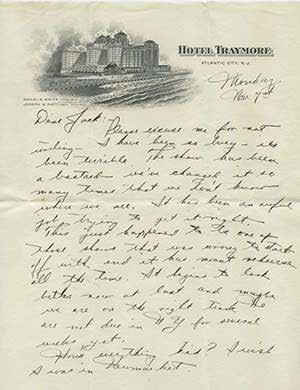
And as for all owners he was fully aware of his Weatherbys account (see left).
His letter to Leach in 1939 discussed silk selection (right), while Astaire’s betting was informed by the British form books, which Leach sent over on a regular basis.

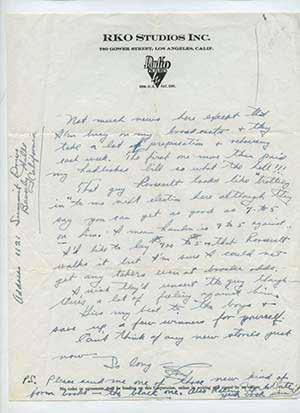
“Thanks for the form book. Now I wish you’d send me one with the seasons [sic] jump races to date. If you send it immediately I can still have time to pick the National winner this year. I really don’t need it but I just want to check up. You see it’s either Blue Shirt or War Vessel and I want
to put a “monkey” on each. Now don’t say I didn’t tell you.
“Glad Crosswire looks to be progressing
and everytime I think of the money we are going to clean up with him it makes me chuckle. In fact I’m chuckling about it as much as Moe Tarsh did before he went broke.
“I went to the Santa Anita Derby to-day

“When does our horse run at Lingfield? Wish you would let me know whether or not I have to register the colors at Wetherby’s or not. I believe you have told me but I can’t remember for the moment. At any rate I don’t know how to work it so you’d better do it. Another thing – what bloody colors shall we have?
“You’d better pick them too. I don’t like green of any sort so almost anything else you suggest will be alright with me. Supposing we try a fairly dark blue with buff sash and sleeves and dark blue cap? If this suits you go ahead and have it made up will you? I think the blue should be as I mentioned above, fairly dark – but bright. Get Felix to pass judgement. Drop me a line soon and also don’t forget those Newmarket wires.
PS Adele has just come out with the brilliant suggestion that buff as a racing color is lousy – and she suggests the following :A “wicked” purple blouse with yellow sash, sleeves and cap. Doesn’t sound so bad does it. Do you suppose that has been done yet? She wants a real vivid purple so try and dig it up. I think after all that this suggestion is better than mine.”
and had my ass trimmed. A filly by the name of Ciencia won it easily. She’s a nice one and just laughed at the colts. However I doubt she can win the Kentucky Derby.
“We finished the new picture and it looks good. It is a more serious story and they say audiences at the try-out performances liked it a lot.”
Astaire liked a bet on a variety of topics and on the presidential election, he wrote: “That guy Roosevelt looks like ‘trotting in’ to the next election here although they say you can get as good as 7 to 5 on him. I mean Landon is 7 to 5 against.
“I’d like to lay 700 to 500 that Roosevelt walks it but I’m sure I could not get any takers even at broader odds. I wish they’d unseat the guy though – there’s a lot of feeling against him.”
Astaire loved his visits to Newmarket and there are reports of him dancing in the bar of The Carlton Hotel, which was a feature of Newmarket High Street for more than 100 years. In its heyday The Carlton patronised by many wealthy racehorse owners and top jockeys.
It was not until after the WWII war and the full return of racing in the US that an opportunity arose for Astaire to have horses in training in the US.
He sent a telegraph to his friend, the New York-based trainer Clyde Phillips: “Dear Clyde, here’s that wire I talked about eleven years ago – buy me two young ones possibly as high as ten thousand apiece if necessary and I hope you are available to train them for me.”
Prominent Kentucky owner Colonel Edward Bradley of Idle Hour Farm had an unraced two-year-old filly by War Admiral he was considering selling and Philips had first refusal.

Eventually, the owner changed his mind and decided to keep her for himself, she turned out to be the 1944 and 1945 champion Busher; it was the closest Astaire got to owning a brilliant, generation-defining champion.
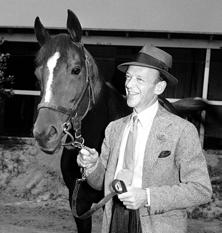
Astaire and his advisor instead spent
$6,000 on a three-year-old colt in training named Triplicate, he was by the 1928 Kentucky Derby winner Reigh Count.
Triplicate won his debut, sadly, Astaire was performing in a United Services Organization tour for troops in Europe and was not at the track to watch.

The colt went on to win his second start by over 4l, beating older and experienced horses.
Astaire did make it to the track to see Triplicate finish fourth at Belmont third time out; the horse was subsequently shipped to California so his owner could watch him more often.
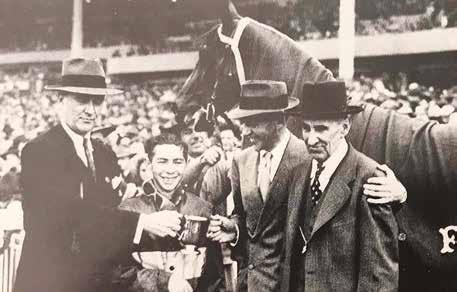
On June 7, 1945, after winning a minor stakes event, Triplicate secured himself a berth in the Santa Anita Handicap in which he finished an honourable fourth.
After the race Philips said to his excited owner: “There is no knowing how good this horse could be.”
I now have three two year old [sic] all sore. They’ve bucked their shins a good while back but now one of ‘em has a knee situation...
In the Santa Anita Handicap he closed late to finish sixth beaten only 2l from a draw of 22 in the 23-runner field with jockey J.D. Jessop reporting that the horse would have won if he’d been granted a clear passage.

A subsequent 5l victory in the 1m4f San Juan Capistrano Handicap within the fortnight righted that wrong and the horse was entered in the $100,000 Hollywood Gold Cup.
Unfortunately, Jeesop was suspended and could not ride, and with jockey plans up in the air, the team engaged young riding star Basil James, who was based in New York.
As just a 16-year-old he been the United States champion jockey by winners and in 1939 when 19 years of age he taken the title of United States champion jockey by earnings.
Come the day, stormy weather led to the cancellation of commercial flights and it looked as though James would be unable to travel but, luckily, Astaire’s friend, the producer Howard Hughes, came to the rescue – he had got to know Astaire while he was courting Ginger Rogers – and the jockey grabbed a flight on his private plane arriving in the nick of time.
The horse, still in the form of his life, made a late outside run under James and got to the line in front to win by a neck.
Later that year Philips died from longterm lung problems and his assistant Lloyd Campion took over. Triplicate never found that level of form again and he was retired with earnings of over $245,000, a decent result from a $6,000 purchase.
He initially stood in Kentucky, and his owner was excited about the plans.
As he wrote to Leach in June 1950: “Triplicate is in stud in Kentucky. He’s 8 and we retired him absolutely sound. He covered 24 mares although we retired him late in the season just after Santa Anita. He never could negotiate the lousy going at S.A. It rained like hell. I guess Harry Wragg told you all about that. Our nice mare has been sent to Trip & been covered & we hope in foal (Over Anxious).”

In the same letter, he expressed many of the frustrations owners feel on a daily basis.
“I sold old Early Bird. He was a useful old plater – won about 10 races for us but his legs were getting sorer & sorer.

“I now have three two year old [sic] all sore. They’ve bucked their shins a good while back but now one of ‘em has a knee situation and the best one, a colt Slot Machine stepped on a stone after running a promising 3rd to good company. I think this one has a chance to be something when the distances stretch out.
“He’s a nice gray Jack & built like a rock
as far as soundness is con-cerned. His stone bruise or whatever it is – is not serious I’m told only I can’t run him for some time of course.
“The other – a nice filly (on the small side) but can run. We had fired for ringbone and now she’s rid of that (for a while anyway) but she ran through a fence & really knocked herself out – so we have to wait for her too. She’s one of those “charmers” & acts so damn cute & cry all the time & bumps herself around.
“She’s nice natured however. Well – that’s the story. I’m digging for some new animals soon if these don’t get going. Have to wait out the colt however, I’m stuck on him.
“I suppose you’ve been knocking ‘em over. I hope so Jack – it sure is pleasant to win races!!!
“Let me know the news of your horses (and also of course your women).”
He also filled Leach in on the Hollywood gossip and wider racing stories in the US.
“I’m doing a movie with Betty Hutton and she’s really a wild one. She’s a good kid but very excitable & when she gets confused or misses anything she’s trying to do, she comes out with anything – no matter who’s around.
Triplicate stood in Kentucky and then moved to Japan, sadly, he did not have a lasting impactI’m digging for some new animals soon if these don’t get going. Have to wait out the colt however, I’m stuck on him
“Its “Oh s**t!” all day long – and “Well F**k That” etc etc. We’ve just done a hell of a funny number that you’ll really like. This picture won’t be out for some time. The one “Barkleys of Broadway” with Ginger Rogers is a hell of a hit & that should hit London soon.”

Astaire remained an active owner, bought a farm in the San Fernando Valley that he named Blue Valley Ranch. He also continued to be a frequent visitor to the UK and enjoyed race days at Royal Ascot, and continued his correspondence with Leach, who by then had retired from training and was writing for the sporting pages.
His breeding interests continued to be dear to his heart: “All is well here. I have a pretty decent filly in Oh Cecelia for Santa Anita. She has only run once as a two yr old and is just coming back and training well. She’s nice and big and seems to have some class. We’ll see!
“I’m pleased about the possibility of a service to Alycidon. Hope it works out. Also – it looks better for Isle of View for her three yr old – according to Harry too.”
Astaire’s first wife Phyllis, who although frequently was at the races with her husband, was not a fan, died in 1954.

The star remained a bachelor for 26 years before falling in love with the female jockey Robyn Smith.
Astaire first met Smith, the first woman to ride a stakes winner when successful on the Alfred Vanderbilt-owned North Sea in the Paumanok Handicap at Aqueduct, when she was riding for the big-name owner on New Year’s Day at Santa Anita in 1973.
By 1972, Smith, who was the first female to ride in a race in Northern California,was winning more races at Aqueduct than any other jockey achieving a 20 per cent strike rate second only to that of Hall of Fame jockey Angel Cordero.
Although she said to the press “I love winning,” she was not a first choice for many trainers, a fact she claimed was due to being a female.
However, Vanderbilt, then chairman of the New York Racing Association, was a
strong advocate and in 1971 the owner said to reporters: “Yes, there’s a tremendous prejudice against girl riders here. A lot of people shudder at the thought of using them.”
Astaire and Smith did not meet again until 1978 when she was in Los Angles to film a commercial. To his amusement and oldfashioned astonishment she called him and invited him to dinner.

She moved to ride on the Santa AnitaDel Mar-Hollywood Park circuit and love blossomed, despite a 45-year age gap.
They married in 1980, and the day after the ceremony she rode at Hollywood Park.
In all Smith rode 247 career winners and retired in August 1980, citing: “Fred thinks riding horses is dangerous. It isn’t, but my No. 1 priority is to keep Fred happy.”
The couple began to sit back from the spotlight and Astaire died on July 22, 1987, the end of a wonderful relationship between the star, the sport, the stage and the screen.

FORGET hats and high fashion, the first ladies and stars of Royal Ascot are undoubtedly Hayley Turner and Hollie Doyle, and both enjoyed winners this year.
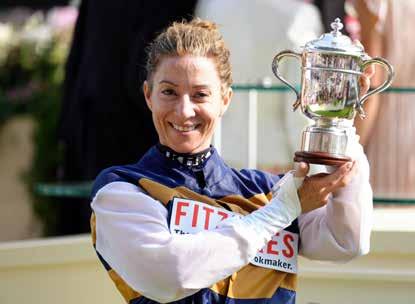
Turner added a new Royal meeting winner to her CV with the victory of Docklands in the Britannia Handicap for trainer Harry Eustace, while Doyle added three to her score taking her to six Royal winners. Her trio included Group 1 success in the King’s Stand Stakes on the Tasleet colt Bradsell for owner Victorious Racing. It was the jockey’s sixth Group 1 win.
Doyle’s last winner of the week came on Saint Lawrence, a five-year-old gelding by Al Kazeem and a homebred winner for the John Deer of Oakgrove Stud.
All Doyle’s wins this year were for trainer Archie Watson.
Hayley Turner
2019: Thanks Be, Sandringham Handicap
2020: Onassis, Sandringham Handicap
2022: Latin Lover, Palace Of Holyroodhouse Handicap
2023: Docklands, Britannia Handicap
Hollie Doyle
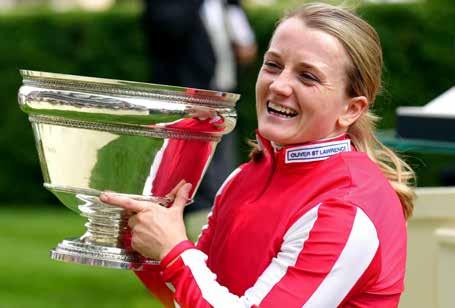
2020: Scarlet Dragon, Duke Of Edinburgh Stakes
2021: Amtiyaz, Copper Horse Handicap
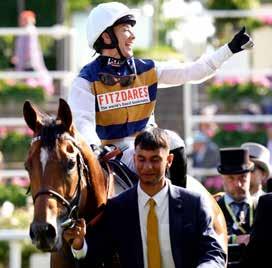
2022: Bradsell, Group 2 Coventry Stakes
2023: Bradsell, Group 1 King’s Stand Stakes
2023: Rhythm N Hooves, Palace Of Holyroodhouse Handicap
2023: Saint Lawrence, Wokingham Handicap
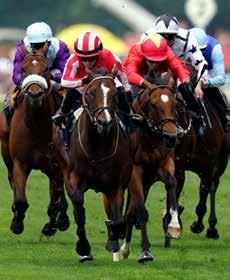
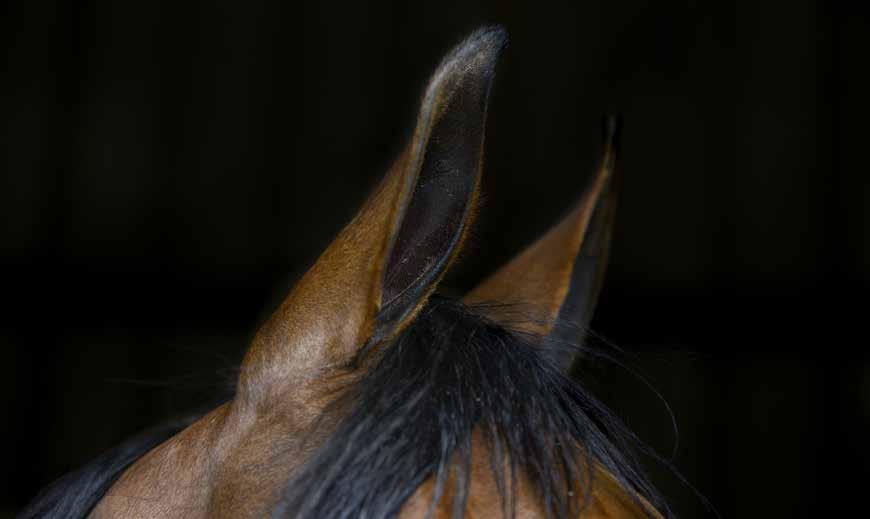
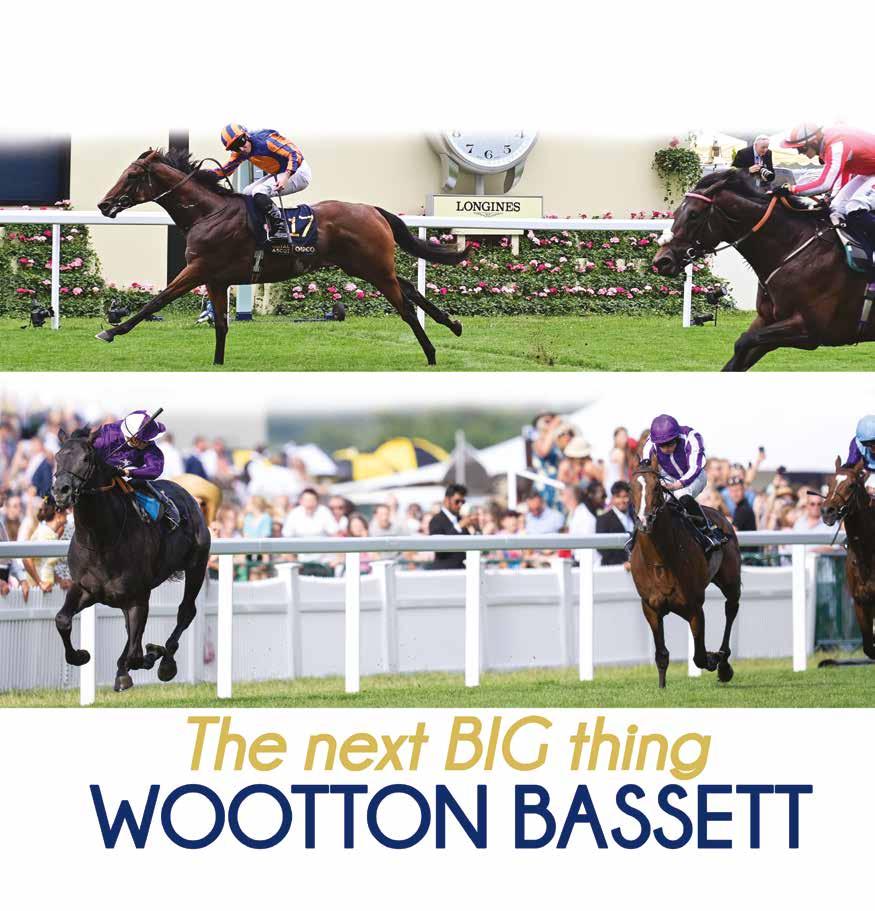
RIVER TIBER remained unbeaten with victory in the Coventry Stakes-Gr.2. Bucanero Fuerte, also by Wootton Bassett, was third.
won
Stakes-
23 Group winners from €4,000 to €40,000 nominations. And remember his biggest and best-bred crops are in the pipeline!